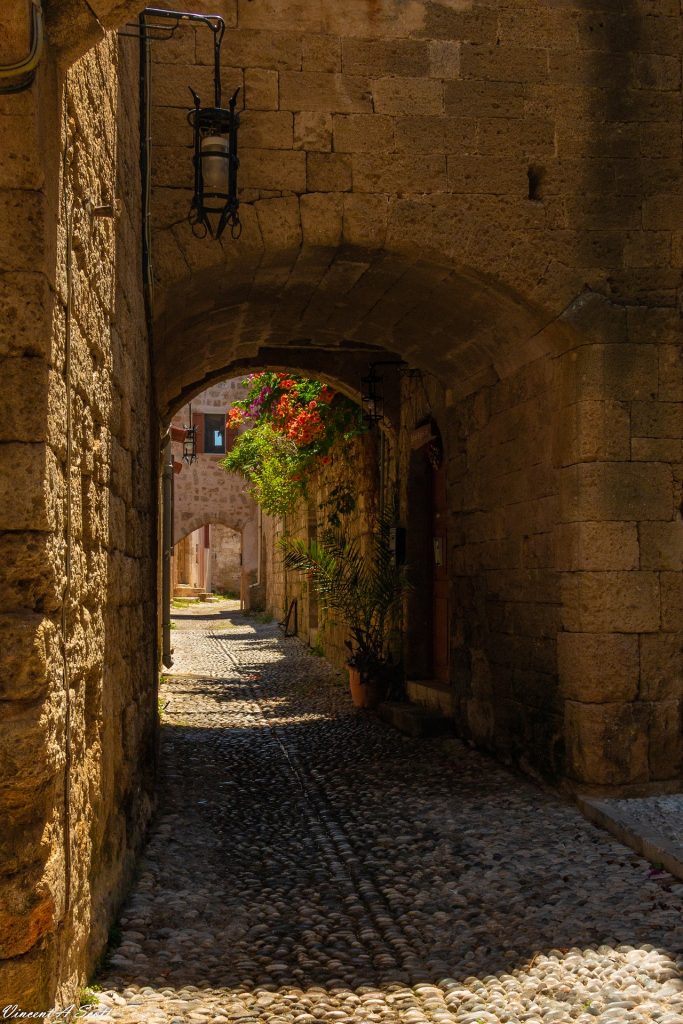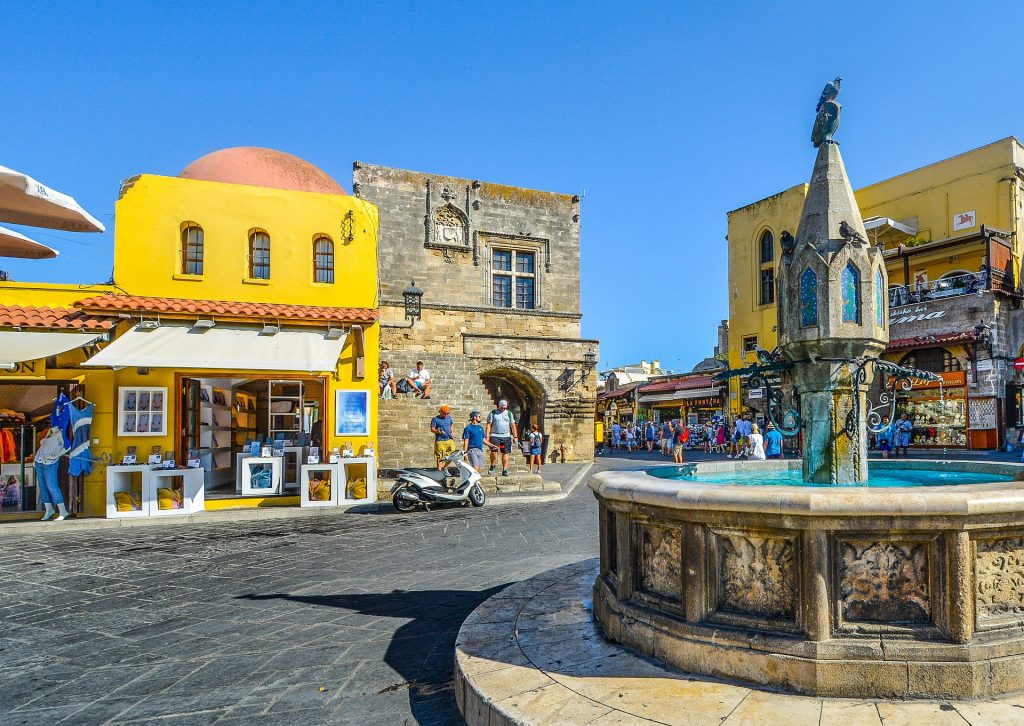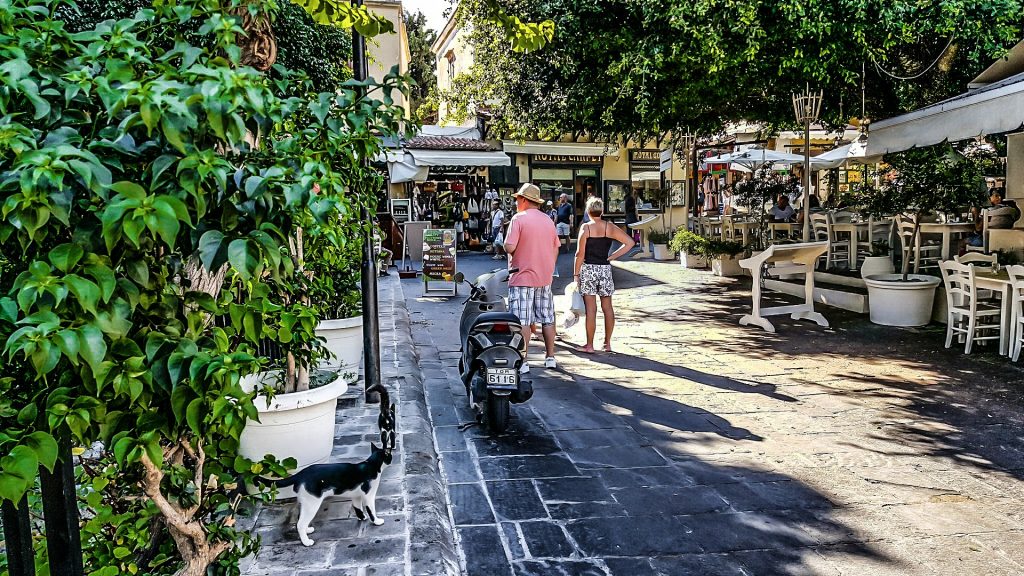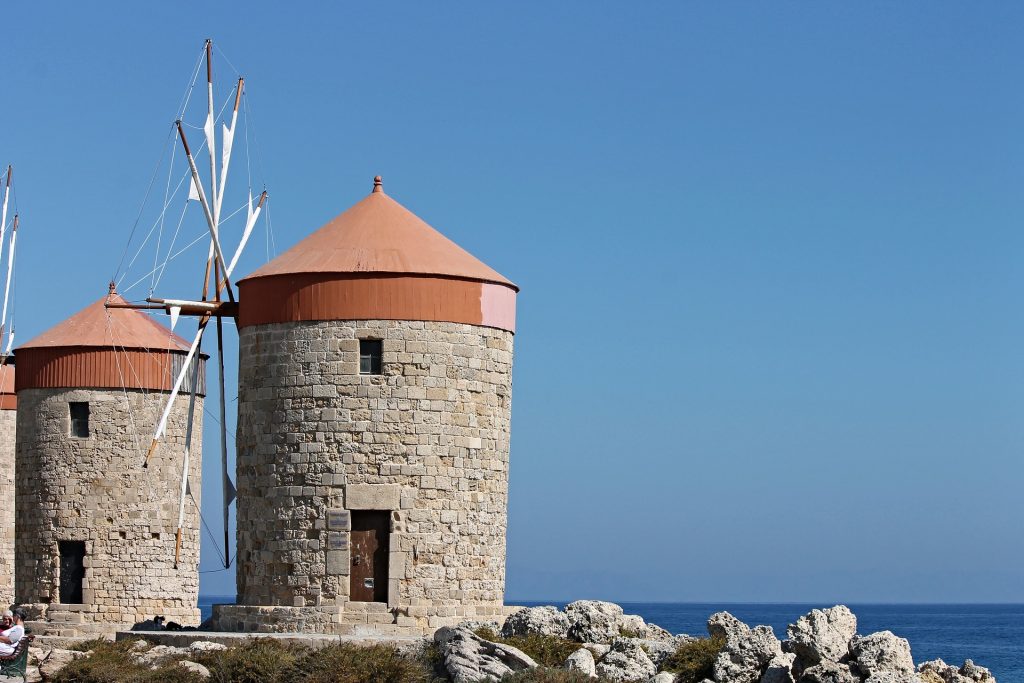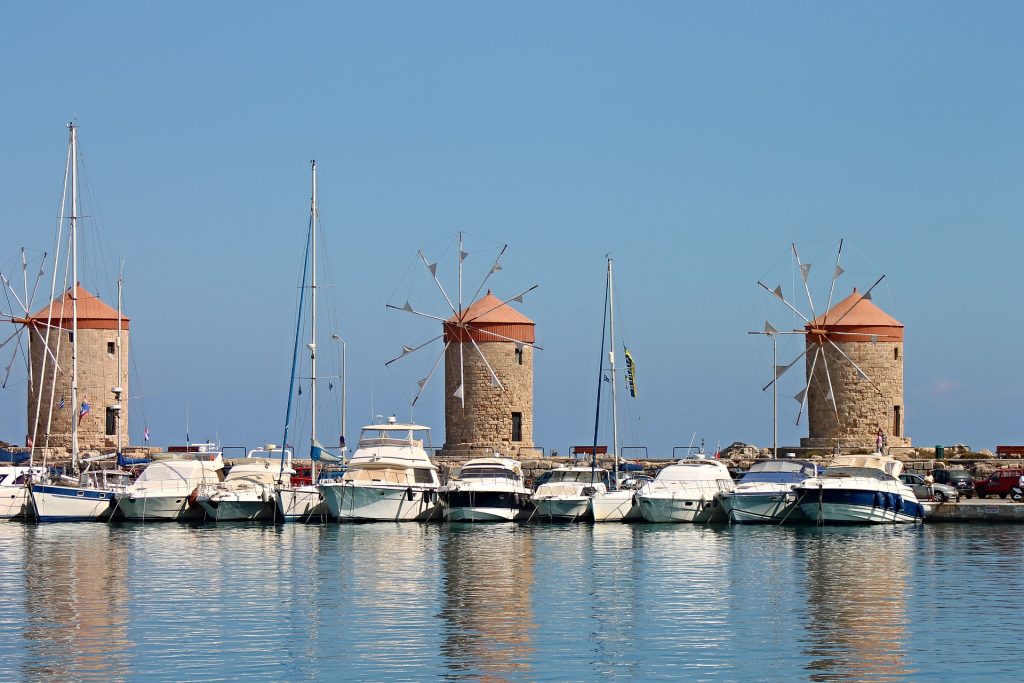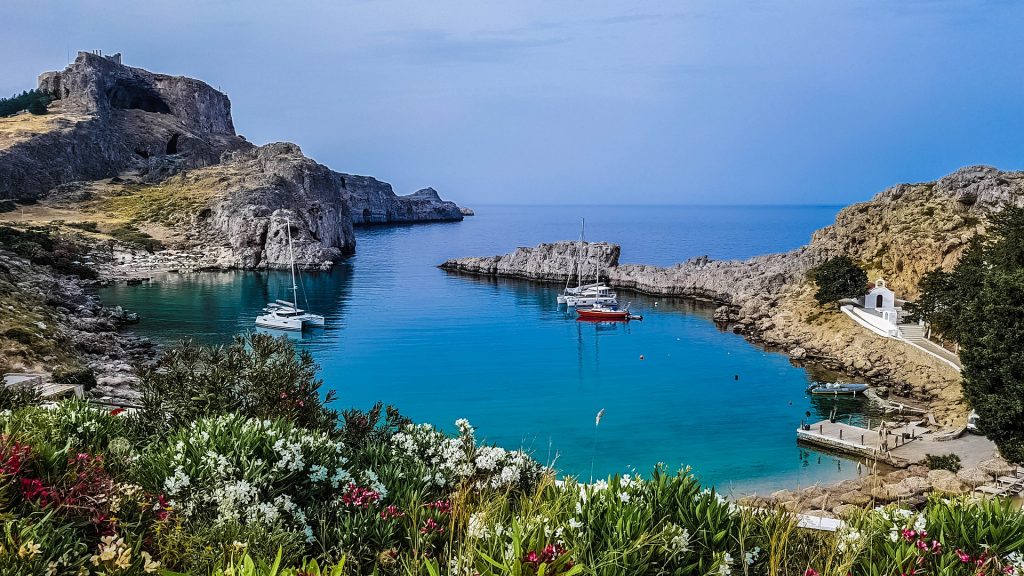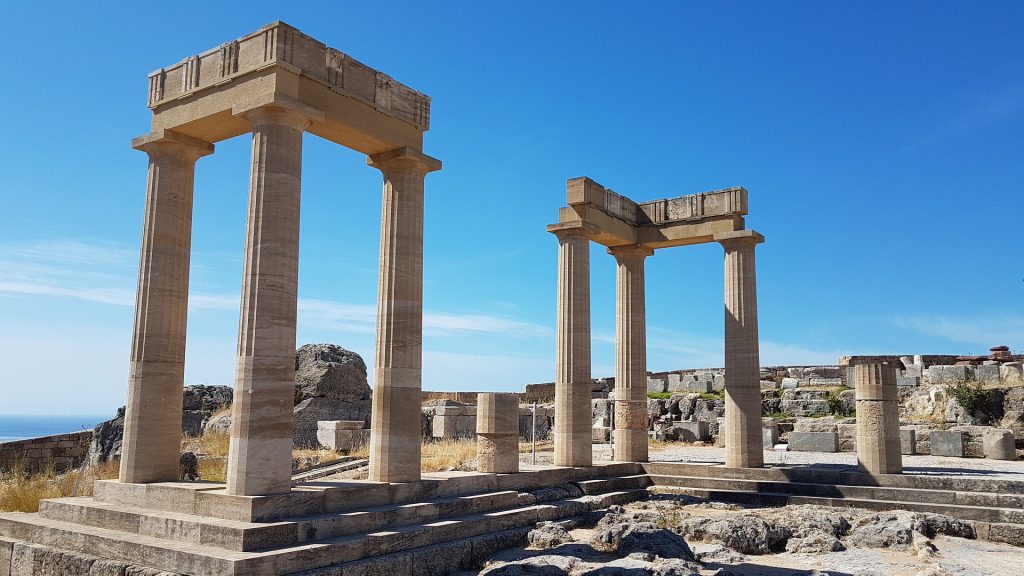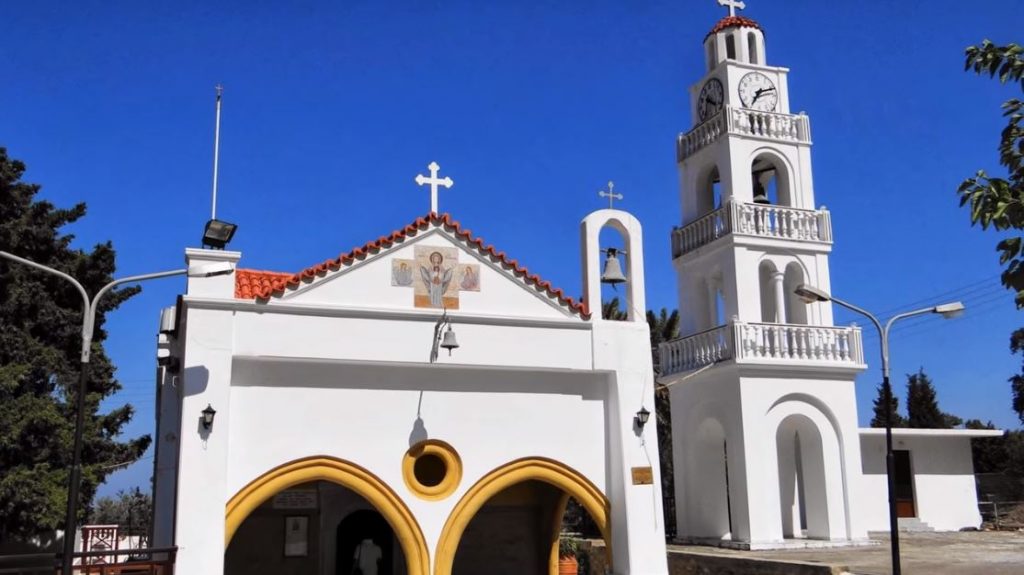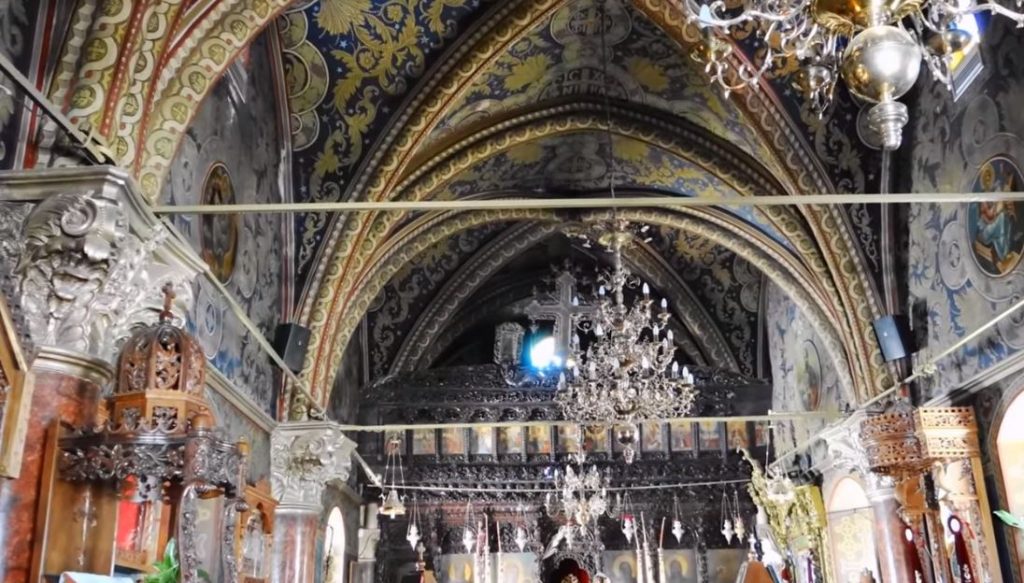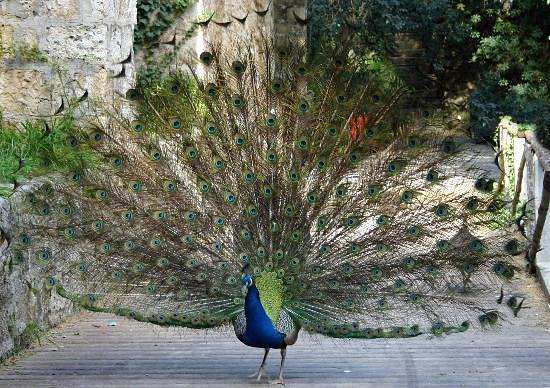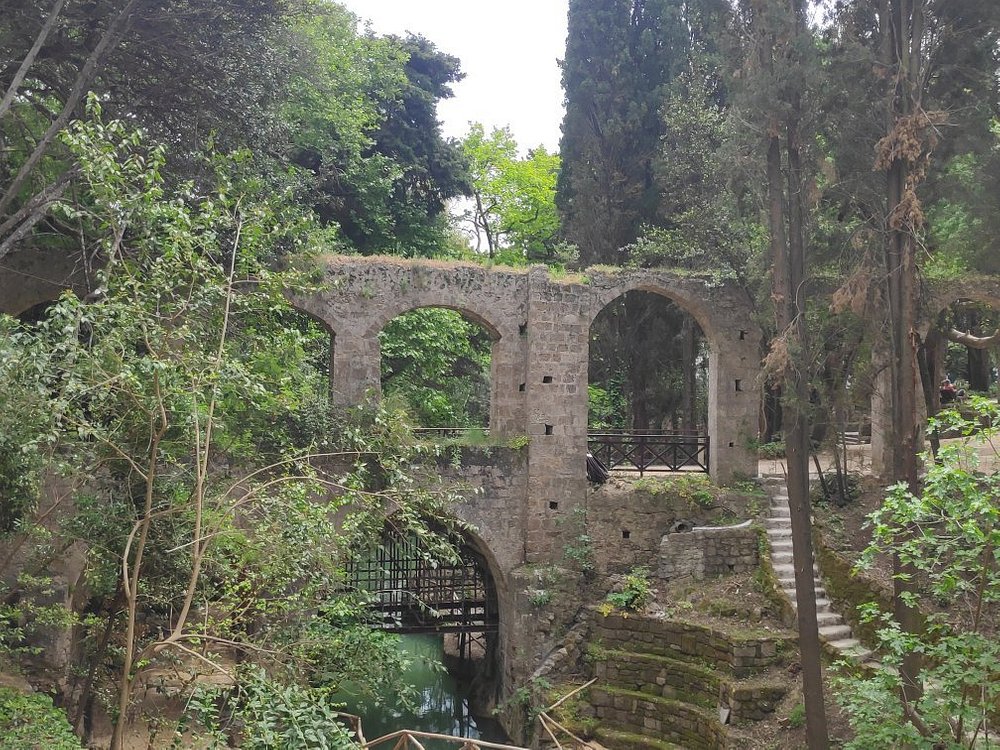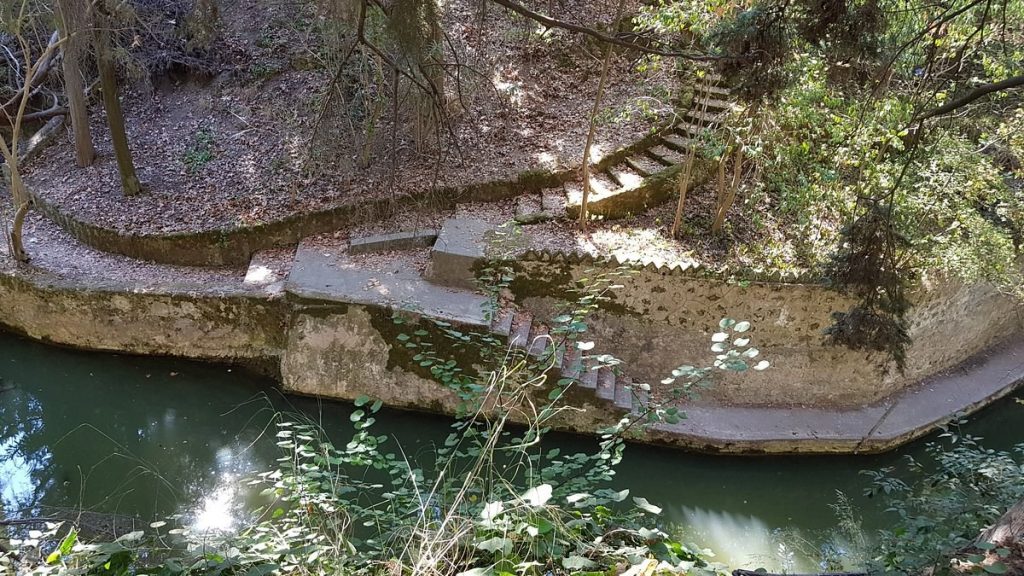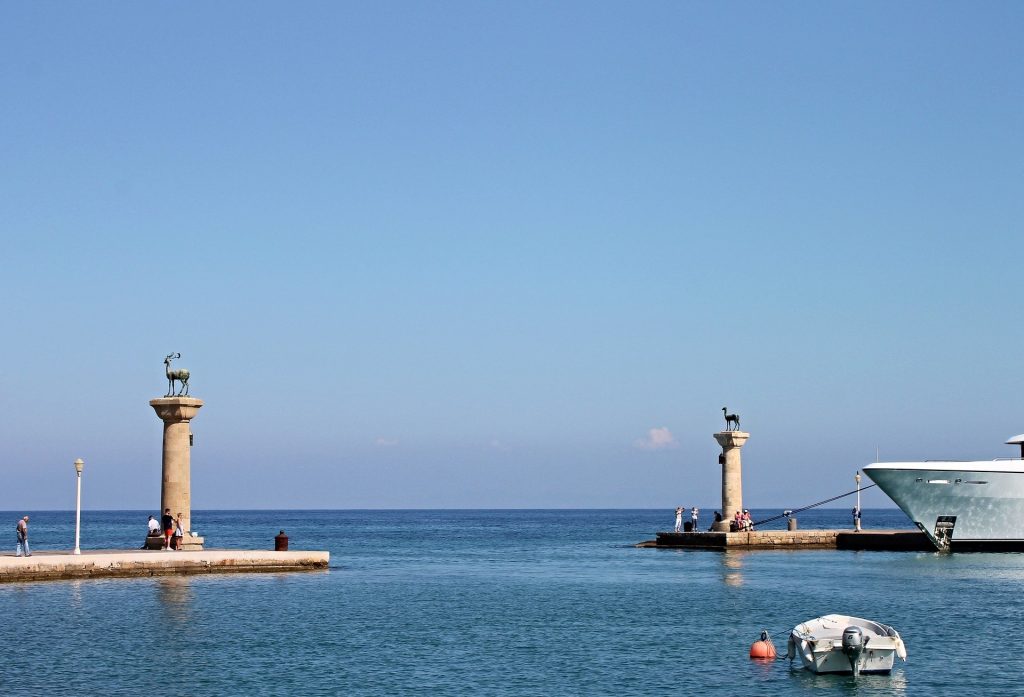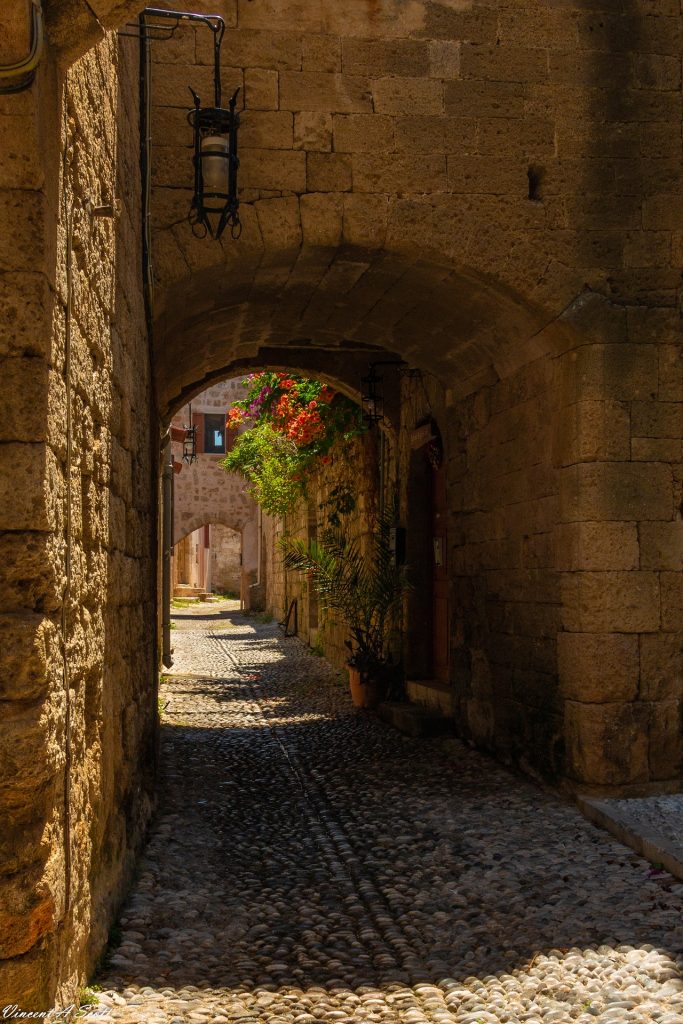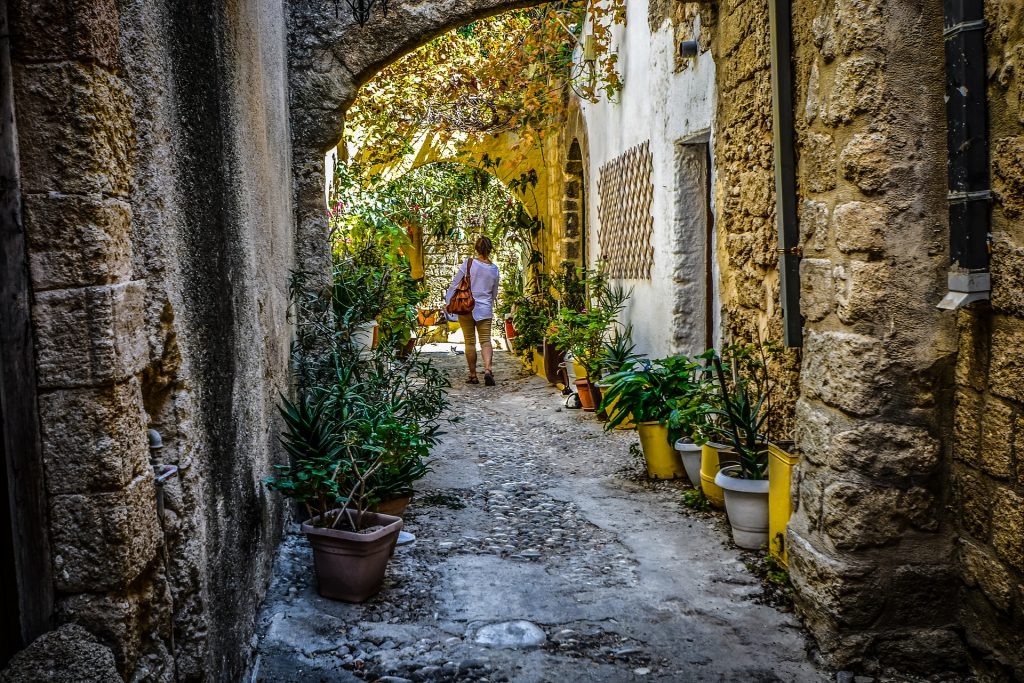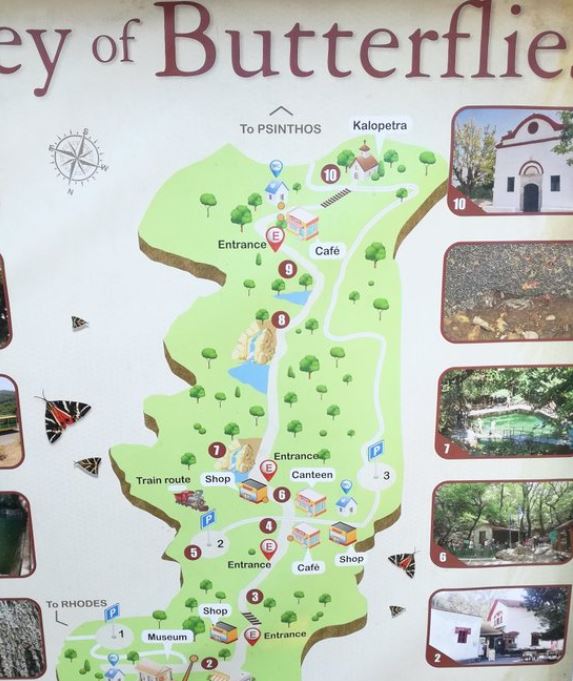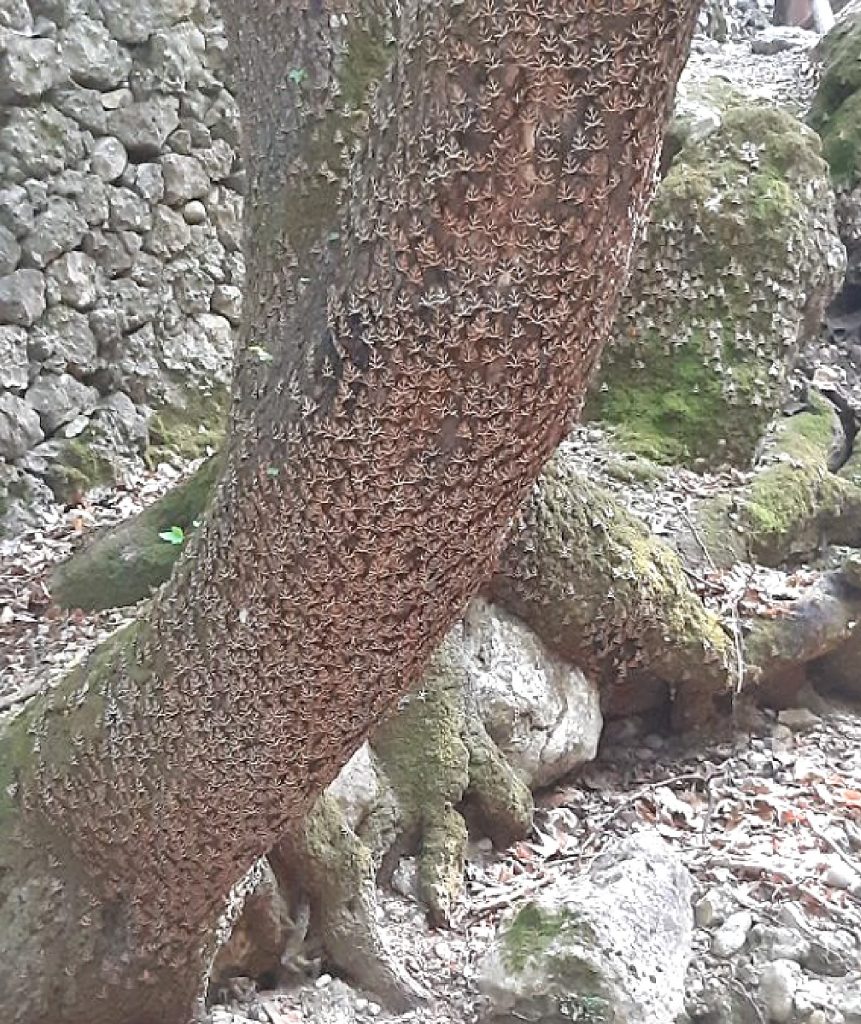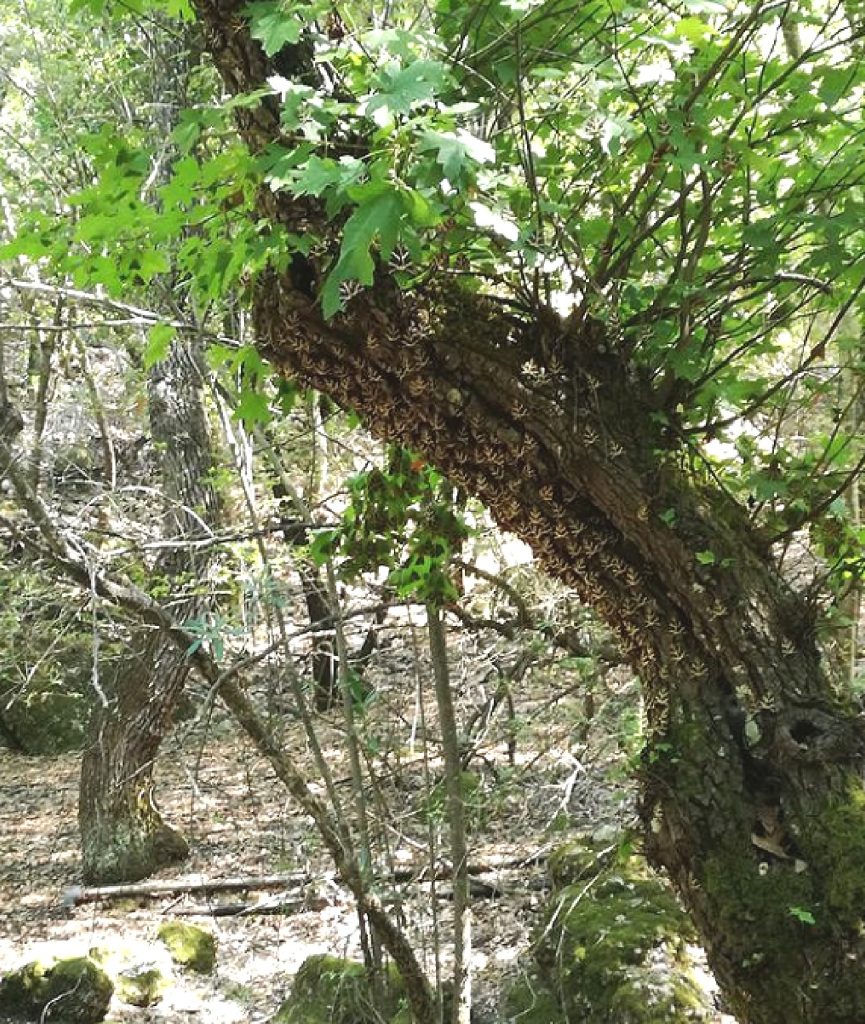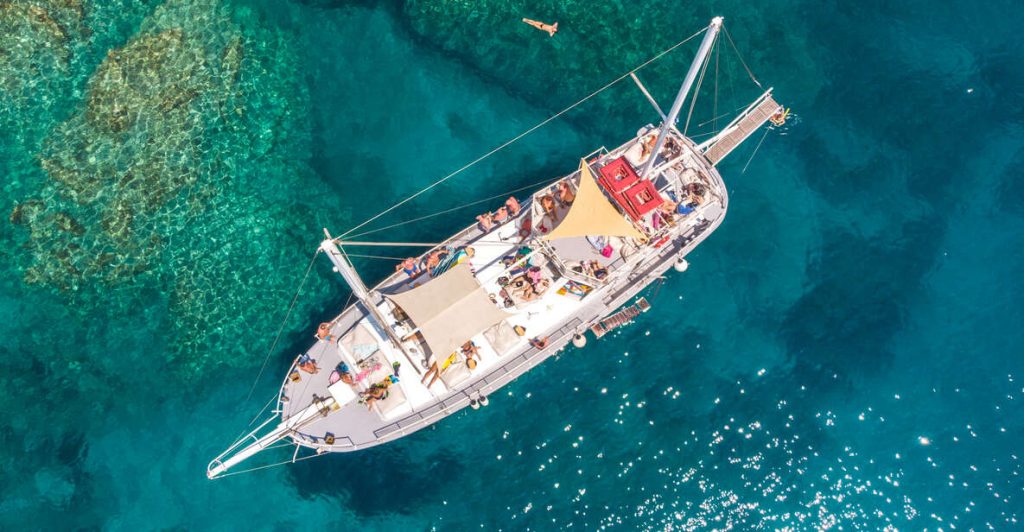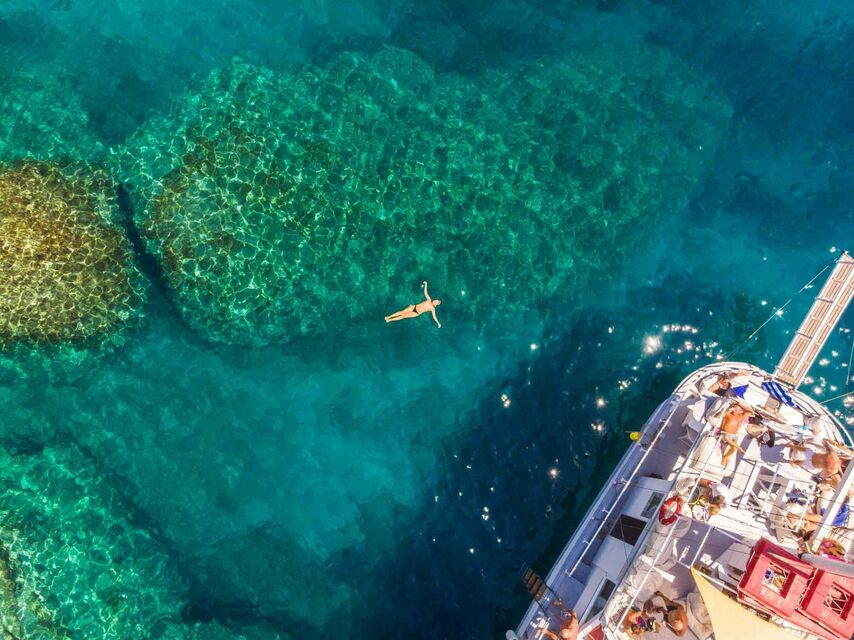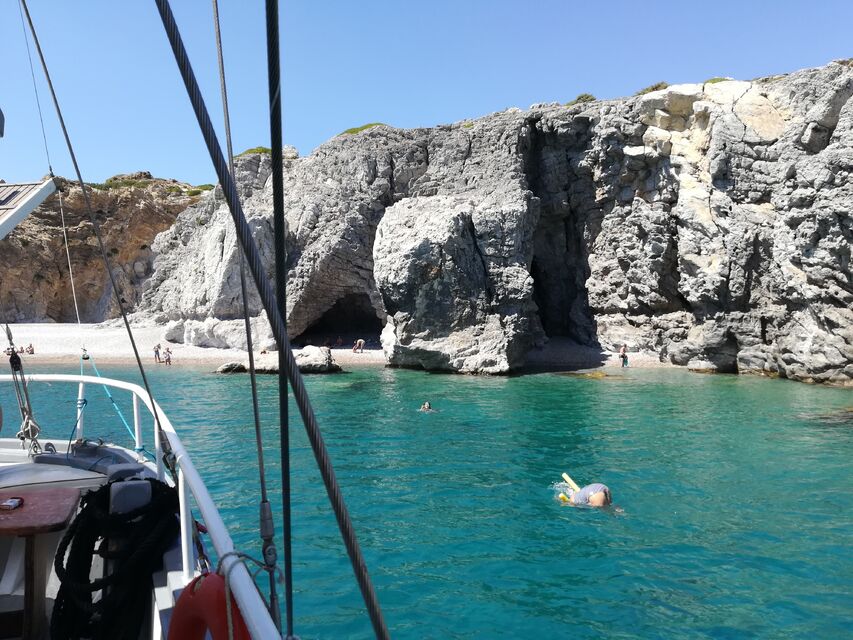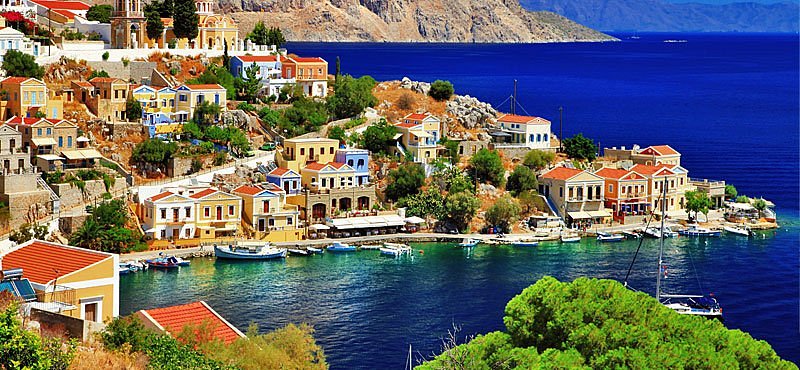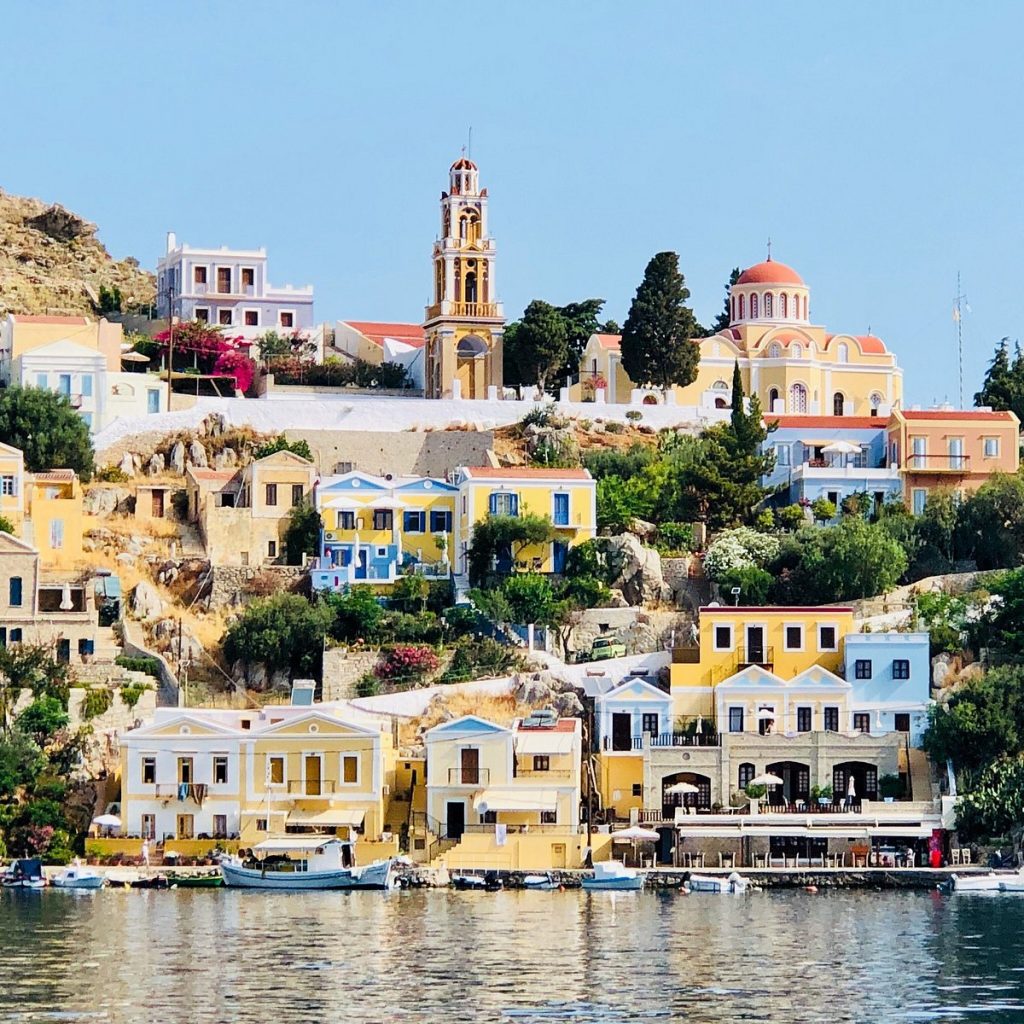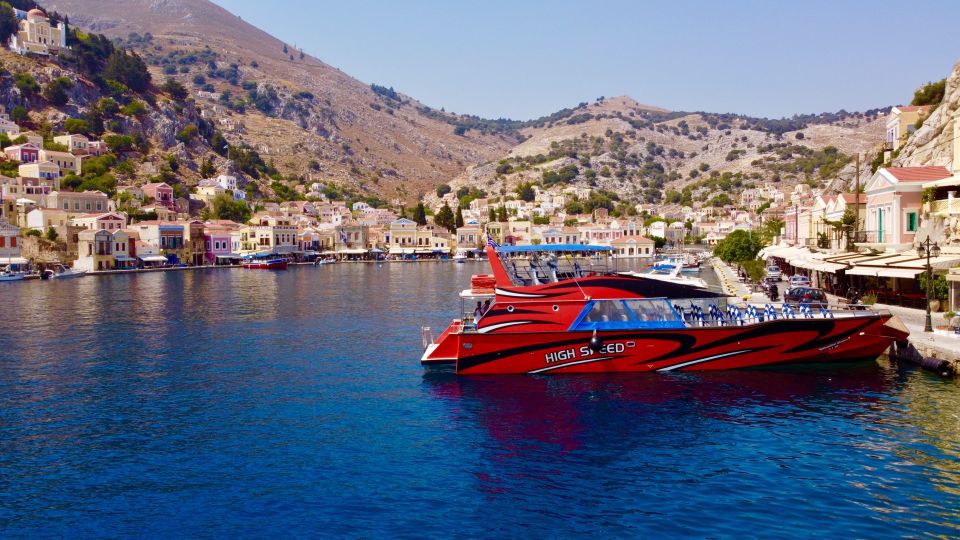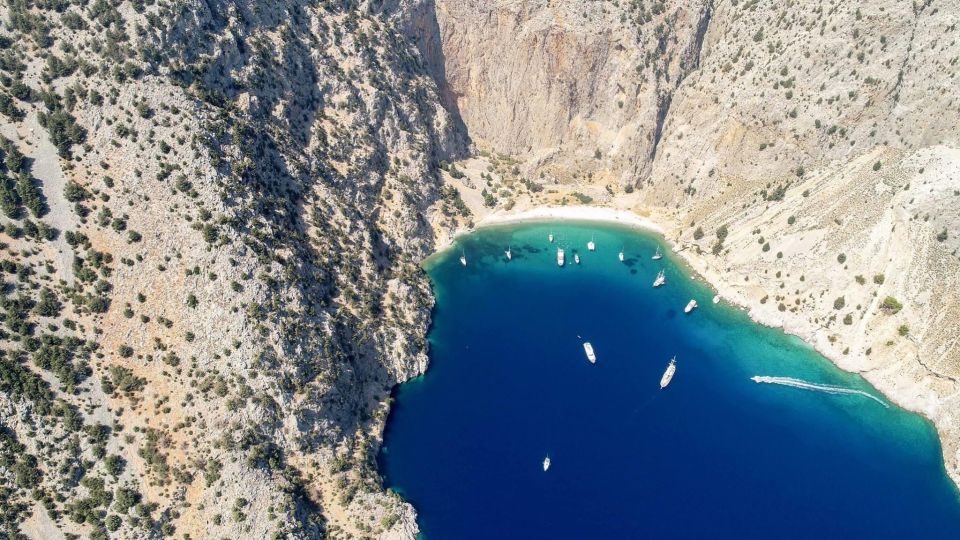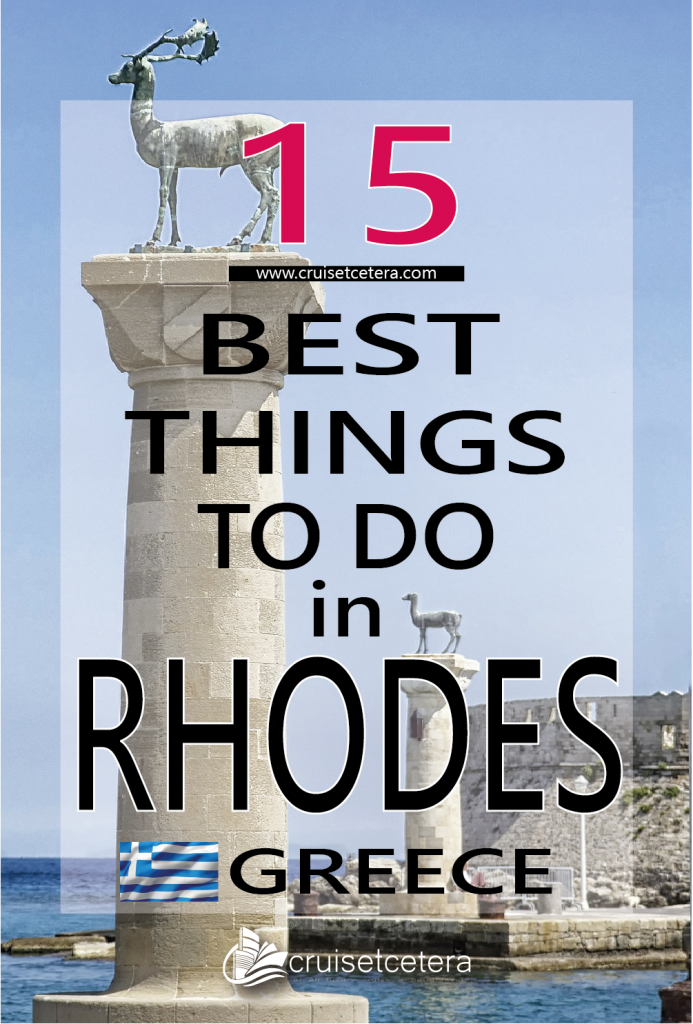
Do you want to visit Rhodes and are looking for the best sights? Then be sure to read on! To help you plan your cruise port in Rhodes, I’ve put together this rundown of the 15 best sights & must-see attractions and activities in Rhodes. You will discover the medieval city of Rhodes, the Acropolis of Lindos, the best beaches on the island and much more.
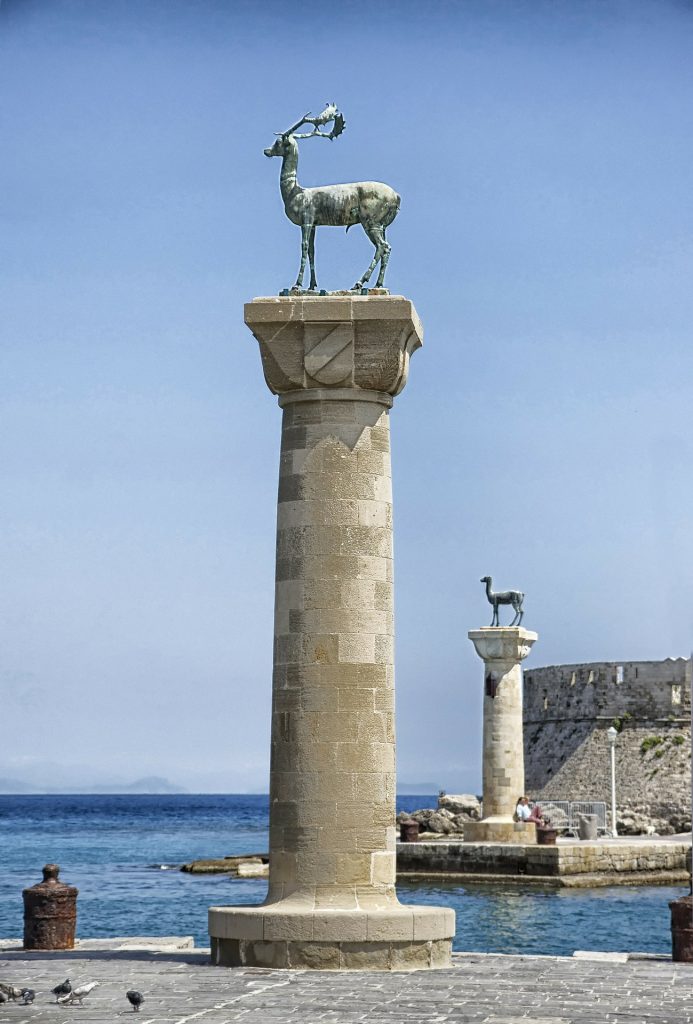
Best known for the Dodecanese Islands, Rhodes is a fascinating architectural patchwork of its past. Here the legacy of the ancient Greeks mingles with that of besieging Turks. But also crusading knights and occupying Italians. The symbol of Rhodes, two bronze deer, guard the Mandraki harbor where the 30-meter-high Colossus is said to have stood. A miracle of antiquity.
The medieval crusader city is dominated by the Palace of the Grand Masters. While cobbled streets lead to the bustling bazaar and a lively harbor that is a hub of the international yacht scene.
Rhodes Greece: Quick Facts
Rhodes with capital, Rhodes City, is a versatile place. It’s almost like a small country, with a history that has touched romantics for centuries. It also has some of the best beaches, archaeological sites, restaurants, and nightlife in Greece.
Rhodes (or Rodes) is an island in the Aegean Sea and the largest of the Dodecanese island complex. It is located on the southeastern edge of the Dodecanese archipelagos, opposite the coasts of Asia Minor, about 9-10 kilometers away.
The island’s population exceeds 115,000, of which about 50,000 live in the capital, and it covers an area of 1,401 square kilometers. It is the 4th largest and one of the most beautiful Greek islands.
The landscape of Rhodes mainly consists of hills and low mountains, most of which are covered with forests. The climate of Rhodes is subtropical and is considered very healthy. Refreshing westerly winds moderate the summer heat, while winter is almost always mild, with long periods of sunshine.
Ancient history
Rhodes has been inhabited since the Stone Age. In prehistoric times, the island was inhabited by Cretans, who were the first settlers on the island. But also by the Phoenicians and Dorians who must have settled on the island before the Trojan War. (1184 BC).
After the Trojan War, the rapid progress and development of the ancient civilization of Rhodes begin. Today examples of this can be seen in the antiquities of the three largest and most powerful cities of the island, Lindos, Ialyssos, and Kamiros.
At the end of the 5th century BC, these cities united into one political power and founded Rhodes. Rhodes reached its peak in the 3rd century BC. Famous artists, philosophers, and writers lived here during that period. From 200 BC it became an ally of Rome and was to have the same friends and enemies as the Romans. But from the 1st century BC, it began, slowly but surely, to go into decline. It was Diocletian who dealt its final blow into independence in 297 AD when he joined the Provincia Insularum of the Roman Empire.
15 THINGS TO SEE & DO IN RHODES
1- The Medieval City of Rhodes City
The medieval city of Rhodes is clearly the island’s must-see attraction. After all, this UNESCO World Heritage Site is the largest and best-preserved fortified city in Europe! When the Knights of Saint-John came to the island in 1309, they decided to build this impressive citadel. The 4 km long defensive walls with many fortresses and towers are very well preserved.
Only pedestrian areas are allowed within the walls. You can take a nice walk and enjoy the charming cobbled streets and historical monuments. Today, the medieval city of Rhodes is completely devoted to tourism. You will find many taverns, restaurants, and shops. The place is very lively in the tourist season which is approximately from early April until October.
The medieval center of Rhodes Town seems straight out of a movie set. The city is surrounded by a crescent-shaped fortress. You enter the city through the gates and you are on winding cobbled streets, seeing medieval vaulted passageways and flying buttresses.
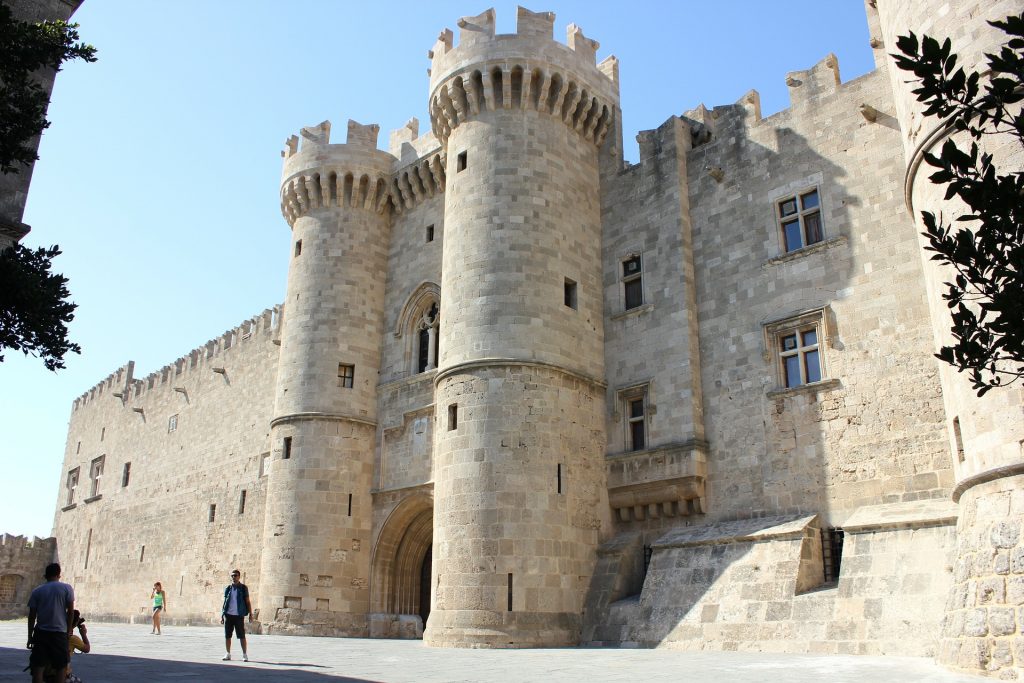
It’s the magical place where you don’t mind getting lost. It also pays to be curious and I can certainly recommend that you take a look at the beautiful courtyards behind the wooden portals. And if you go straight on, the Street of the Knights is located on an old road. This is part of a Gothic ensemble known as the Knight’s Quarter from the 14th century. The road is lined by the facades of inns for the Order of the Knights of Saint John of Jerusalem. All were drafted in different nationalities including English, French, Spanish, Italian, and German.
In the western streets of the old town are faint traces of Ottoman times, at the Hammam and Sultan Mustafa Mosque, both from the 18th century.
The top attractions in Rhodes City are:
- The Palace of the Great Masters of Rhodes: one of the first castles built by the knights. Inside you will discover a museum dedicated to the history of Rhodes and the apartment of the Grand Master with its beautiful mosaic floors. Unfortunately, most of the furniture was destroyed when an ammunition depot exploded in 1856.
- The Archaeological Museum of Rhodes is located in the former hospital of the Knights. There you will find many ancient objects found in Rhodes and the other Dodecanese islands.
- The Street of the Knights: There each country had its own inn (also called “auberge” or “palatial residence”). For example, you will discover the inn of the French or the inn of the English.
- The Byzantine Art Museum with its many frescoes and icons from the Byzantine period.
- The churches of Agia Triada and Agia Aikaterini.
- The Roloi clock tower, to enjoy a beautiful view of the old town from above.
- The Suleman Mosque, built during the Turkish occupation of Rhodes.
2- Mandraki Port
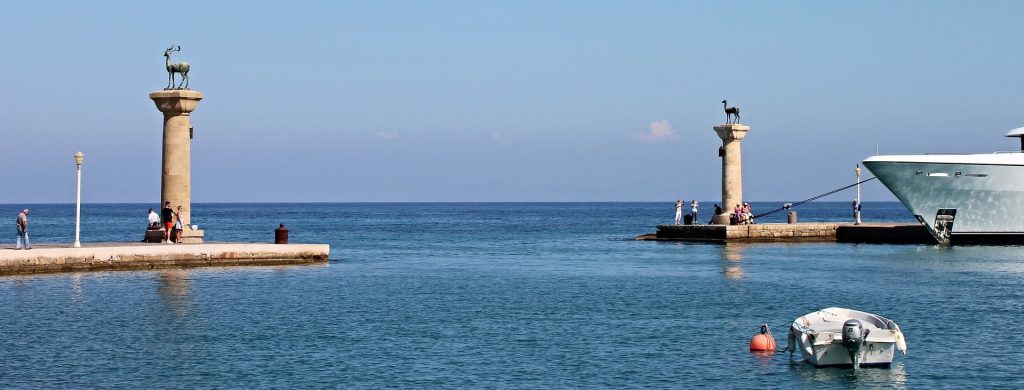
After visiting the old town of Rhodes you can leave the city walls to visit Mandraki. This is the modern part of the city. The northernmost of the three ports of Rhodes Town is Mandraki Port. This port is best explored on foot, with a long pier on the east side leading to the Fort of Sint-Nicolas.
In the harbor, you can see the 3 mills of Rhodes and the place where the famous Colossus of Rhodes was built. The 30-meter-tall statue of the sun god Helios was completely destroyed in an earthquake in 226 BC. It was then replaced by 2 small statues representing a deer and a roe deer. It has been the symbol of Rhodes ever since. These statues are placed on 2 columns at the entrance of the harbor. They are, of course, not as spectacular as the colossus. It was considered one of the 7 wonders of the world!
In Mandraki you will find many beautiful monuments built during the Italian occupation of Rhodes. The Bank of Greece, the Archbishop’s Palace, the Town Hall, and the National Theater of Rhodes.
This place started out as a watchtower in the mid-15th century but became a full-fledged fortress in 1480 under Grand Master d’Aubusson. This is also the alleged location of the Colossus of Rhodes on the Seven Wonders of the World.
There is also a casino and many international clothing stores such as Zara or H&M should you wish to shop. If you are visiting Rhodes with children, you must go to the Aquarium north of Mandraki. This is located right next to the Casino.
In the modern city of Rhodes, you will also discover the remains of the Acropolis of Rhodes, which is located 2 km from the old town. It is located on the slopes of Monte Smith. There you can also see the remains of the stadium, the theater, and the Pythian Temple of Apollo. This archaeological site is quite small, but entry is free.
3- Lindos & the Acropolis
Lindos is highly recommended because it is one of the most beautiful villages on Rhodes. It is certainly one of the best places on this island. It takes about 1 hour to reach the village. It is located about 50 kilometers south of Rhodes City. Lindos is classified as one of the most important archaeological sites. It’s a real postcard landscape. You will be amazed by the beautiful white houses on the hill and by the Acropolis overlooking the village and the sea.
As Lindos is also a car-free town, you have to park your car in the free car park above the town and then walk to the entrance of the village. The taxi can of course drop you off in a good place.
Walking through the cobbled streets you will discover numerous souvenir and clothing shops and many cafes and restaurants. If you are looking for a lively and unique atmosphere, Lindos is definitely a great place to visit!
The Acropolis is probably the main attraction of Lindos. You can discover it on foot or with a donkey ride. Still, I would leave the donkeys alone and start walking, because the animals are often abused.
The Acropolis of Lindos, built on a huge rock, is 116 meters above sea level. It is surrounded by fortified walls built by the Knights of Rhodes. In the Middle Ages, it was one of the safest fortresses on the island.
Cruisecetera Tip: If you want to take beautiful pictures of Lindos and its Acropolis, the perfect vantage point is on the road before arriving at the village. Visit the Acropolis early in the morning or at the end of the day. The temperatures will be a bit more pleasant and you will avoid most of the tourists.
Within the walls, you will discover the remains of an ancient theater and the last remains of the Temple of Athena. It is built on top of the Acropolis. Only a few columns remain, but the place is still worth a visit. From there you can enjoy a breathtaking view of the Aegean Sea and the village of Lindos.
Of course, you can also opt for organized tours from your cruise line or from the local providers.
I have some recommendations for you for awesome trips:
- From Rhodes City; High Speed Boat Trip to Lindos A day-trip to Lindos from Rhodes Town aboard a high-speed boat. Enjoy 4 hours of free time in Lindos to visit the Acropolis, explore the village, and swim at a beach.
- From Rhodes City: A full-day Boat Trip to Lindos Visit the stunningly beautiful village of Lindos by boat. Stop at magnificent beaches along the east coast and go for a swim. Enjoy 3 hours of free time to explore the ancient Acropolis of Lindos on your own.
4- The best beaches of Rhodes
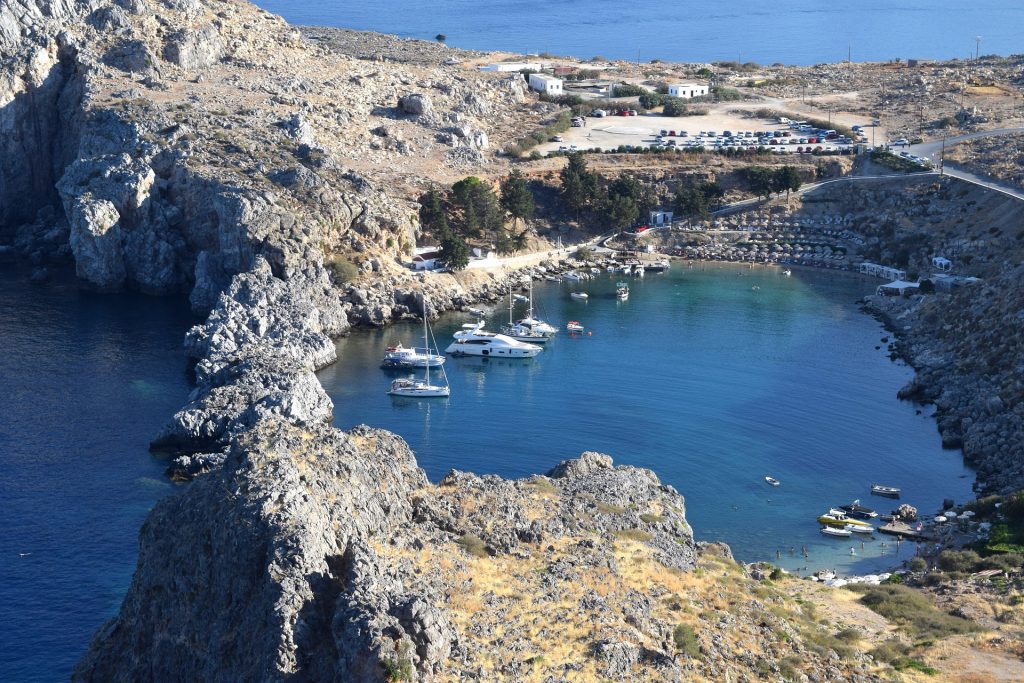
Are you a beach lover and you want to relax on the beach and swim in crystal clear water? Then the island of Rhodes is clearly a great cruise port. There are a lot of beaches on this island but the best beaches to go swimming in Rhodes are:
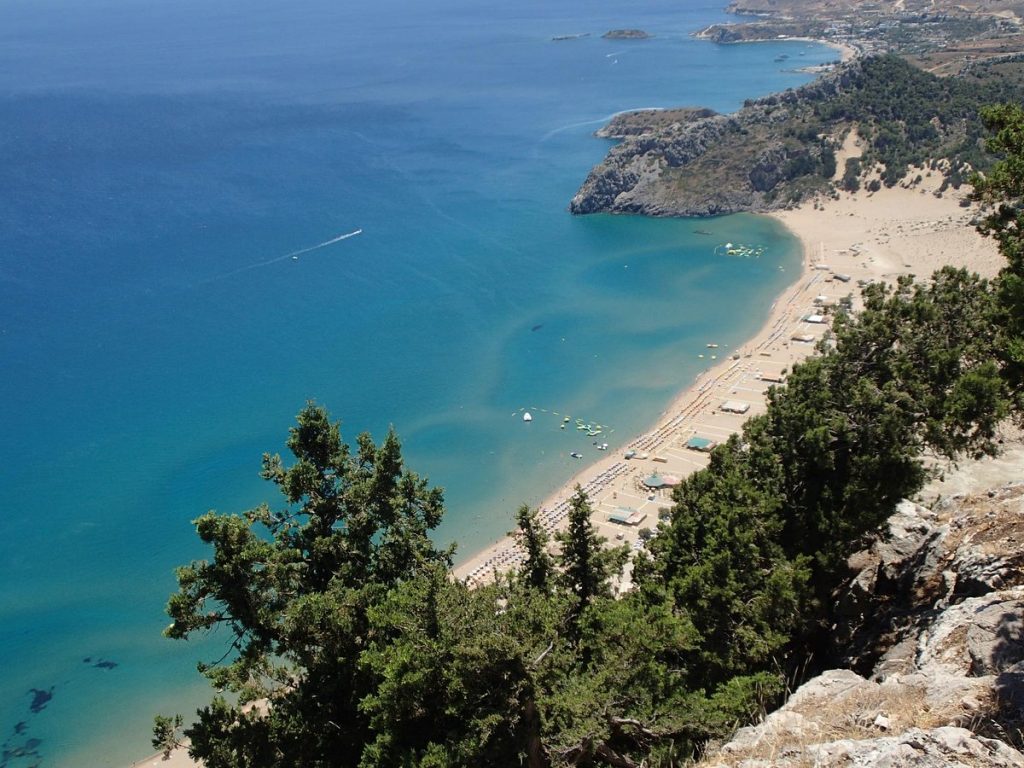
–Tsambika Beach: A fine sandy beach and ideal for children. Here you can rent sun loungers and parasols and do many nautical activities. Located below the monastery, this is a beach almost too perfect to be true.
Tsambika Beach is 800 meters of fine golden sand enclosed on three sides by craggy slopes coated with garrigue and pines. The beach is low-shelving and wide, accommodating several rows of sun loungers and parasols, and marked by flags is a sequence of beach bars and restaurants. If you get bored of paddling in the shallow emerald sea there’s a watersports center on the beach for more exhilarating activities.
–Anthony Quinn Beach: This beach was named after the main actor of the movie “Sorba the Greek” because it was his favorite beach!
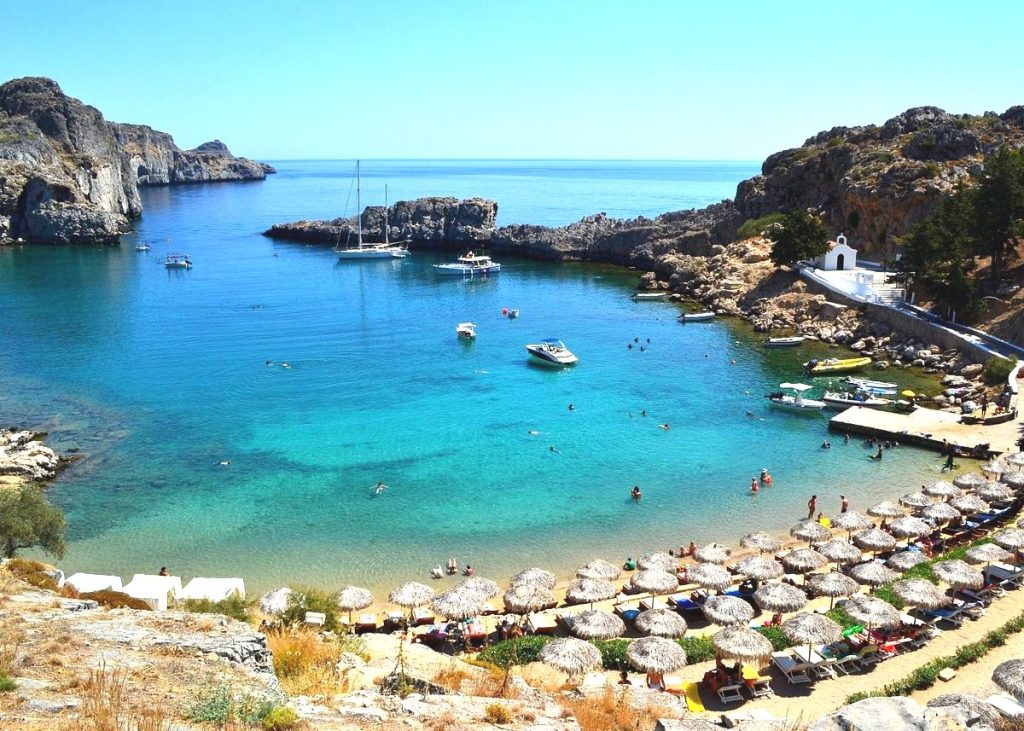
–Saint Paul’s Bay, or Saint Paul’s Beach; Here you will find 2 small beaches with a beautiful view of the Acropolis of Lindos. Most of the beach is private. There is also a lovely white chapel that hosts a few weddings every year. A romantic place! A bathing spot with a view to treasure. You can recline at St Paul’s Beach and contemplate the Lindos Acropolis on its soaring throne.
The main, sandy beach is on the southern curve of an ovular bay with just a small opening on its northeastern side. On the north end, right beneath the acropolis, is another smaller pebble beach. Both fill up quickly in summer when you’ll be sharing the beach with hundreds of people. But that takes nothing away from the main attraction which is the transparent sea, tranquil and shallow enough that even non-swimmers can wade in and relax.
–The beaches at Lindos; Located below the village. It is clearly a great place to relax and take a lovely, refreshing swim after visiting the Acropolis.
–Afandou: Especially ideal if you are with children. So could be a bit busier.
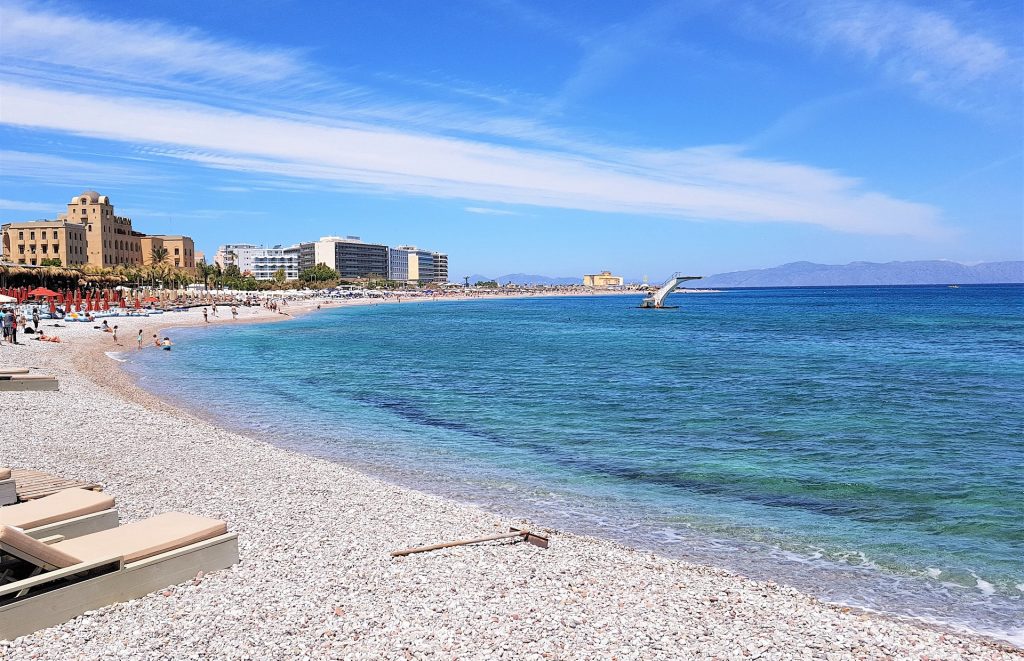
–Faliraki Beach: This beach is located 10 km south of Rhodes City. It is one of the most famous and most visited beaches on the island. Here you will find many large all-inclusive hotel complexes. If it is that you like…. this is the place.
–Prasonisi: (on the south side of the island) Is one of the most beautiful beaches of Rhodes. This sandy beach separates the Aegean Sea and the Mediterranean Sea. It is also a great place for windsurfers!
–Gennadi; This is a beautiful and quiet pebble beach. The water there is very clear, so it is perfect for snorkeling. You can also rent sun loungers here.
–Kiotari; Is a sandy beach with its own section and several cozy Greek taverns.
–Vlicha (or Vlycha); This is also a good choice, especially if you are traveling with your kids. There you can rent sun loungers and try out some restaurants.
–Pefki; Located just 4 km away from Lindos, but still very quiet.
–Glystra; Has fine sand and crystal clear water.
–Agathi; Is a small beach mainly frequented by locals.
5- Palace of the Grand Master of the Knights of Rhodes
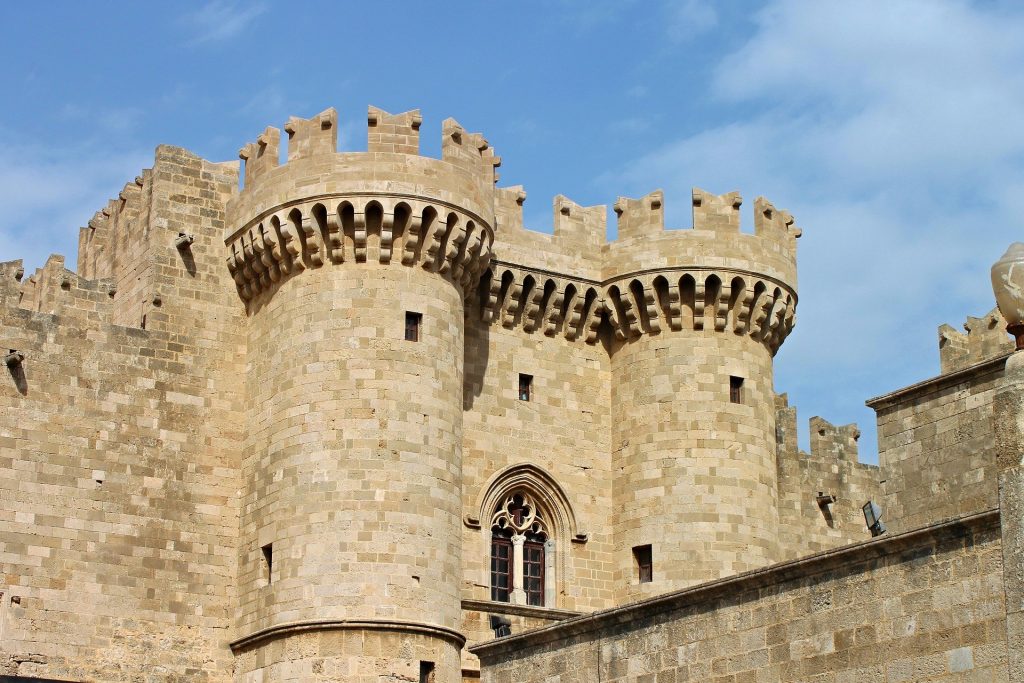
This castle is one of the few examples of Gothic architecture in Greece. It belongs to the World Heritage of Rhodes Town and has roots dating back to the 7th century when it was a Byzantine citadel. The castle’s heyday was in the 14th century when the Knights Hospitaller turned the fortress into their power base. It became a luxurious residence for the grandmasters of the order.
When Rhodes was under Italian control in the 20th century, the damage was repaired by a 19th-century explosion. Benito Mussolini then chose the castle as his residence.
Today the palace is a museum with artifacts from all over the Dodecanese. Such as some beautiful mosaics from the Greek island of Kos. It tells the story of a monument and showcases the ancient architecture of the Great Hall and the arcaded courtyard.
6- The Tsambika Monastery
The Tsambika Monastery is another place that is definitely worth a visit in Rhodes. Especially because of the beautiful history and the story behind it. That makes it even more special. Because a recurring theme on Rhodes seems to be that difficult climbs are rewarded with interesting monuments and breathtaking views.
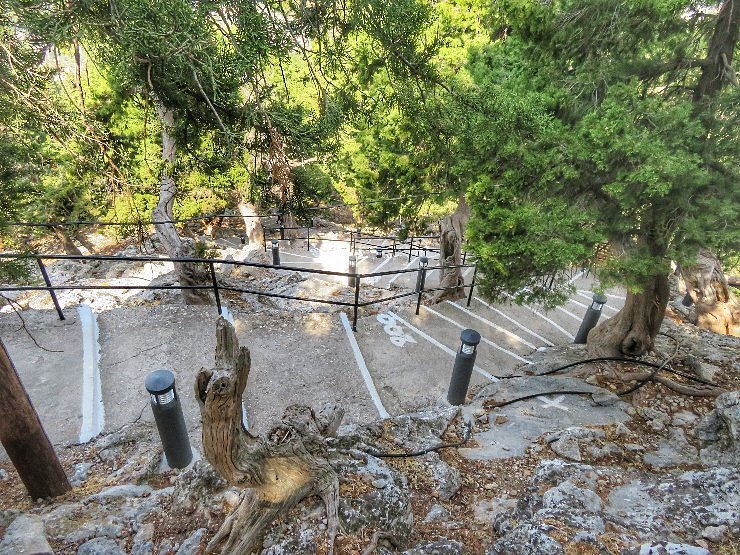
That is certainly the case with this church in a natural park above one of the best beaches on the island. The monastery is in fact a very small Byzantine church built on a mountain. To get there, you have to climb more than 300 steps! Fortunately, the path to this place is mostly in the shade and there are also many benches to rest. Take your time and climb up slowly. Trust me it’s really worth it!
Traditionally, women struggling to conceive made the pilgrimage to the church barefoot to pray to the icon of the Virgin. The church is dedicated to the Virgin Mary. Then, when they became pregnant, they had to name their baby Tsambikos for a boy and Tsampikas for a girl.
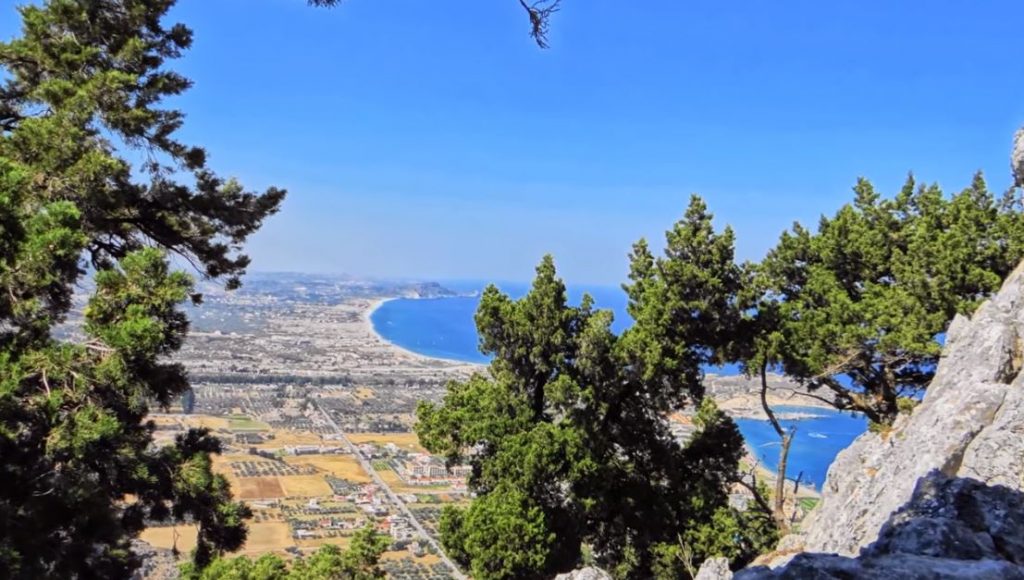
Once at the top, you are 300 meters above sea level and you will be rewarded with a beautiful view of Tsambika Beach and most of Rhodes.
To the north, you can look down on the small seaside town of Kolymbia, while you can look south to the Acropolis of Lindos which is 20 kilometers away.
The church itself is from the 18th century and built in the Dodecanese style, with hollow roof tiles.
7- Archaeological Museum of Rhodes
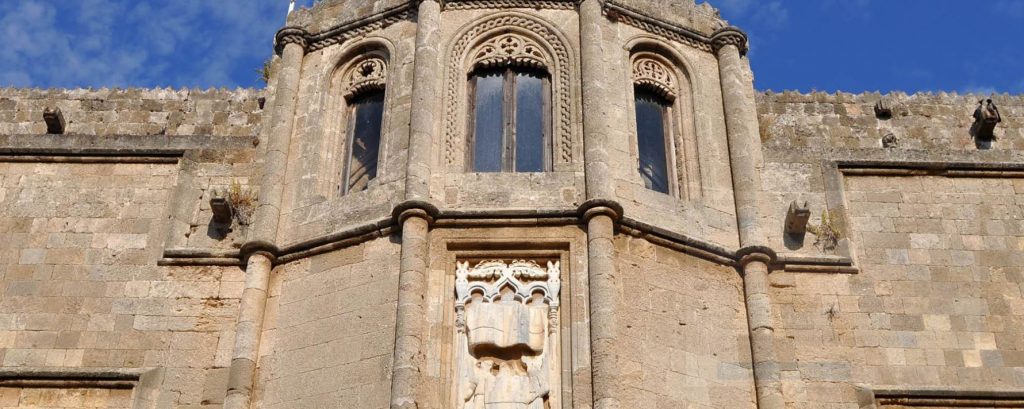
The Archaeological Museum of Rhodes is housed in the medieval building of the Hospital of the Knights. Its construction was completed in 1489 by the famous Grand Master d’Aubusson.

It is a two-story building, with a courtyard, which is lined with porticos on all four sides. In front of the west arcade in the courtyard, you’ll see the Hellenistic funerary monument of a lion holding a bull’s head between its legs. Along the porticos, you can see numerous inscriptions, tombstones, and circular altars. The museum rooms are located on the first floor. The small rooms overlooking the courtyard contain burial finds from ancient Ialysos and Kamiros, dating from the Geometric, Archaic and Classical periods.
The most interesting galleries are those with a collection of sculptures from the Archaic, Classical, Hellenistic, and Roman periods. Another notable piece to track down is the 1st century BC statue of the crouching Aphrodite. Modeled after the famous Hellenistic representation of Aphrodite attributed to Doidalses two centuries earlier.
There are also vases and sculptures of Kameiros, amazing mosaics, steles, and capitals. As well as the medieval tombs for knights and coats of arms collected from buildings in the city. Finally, the marble head of Helios (250-160 BC), gives a wonderful example of Hellenistic Baroque.
8- Rodini Park
Rodini Park was probably the first landscaped park in the world. It was still popular with the Romans years later and they left a bit of an aqueduct here.
The park is laid out along a natural stream. This is an ideal environment for the peacocks that live and breed freely in the park.
It is wonderful to walk through the park and also to take a rest from the heat of the day. Enjoy the cool walking path along the bank of the creek. A 10-minute walk will take you to a rock-cut tomb. The tomb, dating from the Hellenistic period and decorated with 21 Doric half-pillars, is known as the Tomb of the Ptolemies.
Rodini Park is rich in flora. With perennial plane trees, oleanders, tall pines, springs with water flowing through the rocks. It offers relaxation areas, a playground, park benches and gives its guests a sense of peace and tranquility.
9- The Colossus of Rhodes
The Colossus of Rhodes or Rhodes was one of the Seven Wonders of the Ancient World. The Colossus was a bronze statue of the Greek sun-god Helios, who was revered by the Greeks and later synthesized with Apollo, the god of light. Every trace of this colossus has disappeared.
The huge bronze/stone-carved statue was built to thank the gods for the victory over Demetrius Poliorcetes’ (305 BCE) long siege of Rhodes.
The Colossus of Rhodes was not just a giant statue. It was a symbol of unity of the people who inhabited that beautiful island of Rhodes in the Mediterranean. On the alleged site of this huge statue with one foot on each side of the gate, now stands the well-known symbol of Rhodes. The two bronze deer.
10- Villages in Rhodes
To discover the real authentic Rhodes, you can look a little further than the most touristic spots. In the mountain villages of Rhodes, you will find some of the most beautiful places on the island. Some villages seem to be hidden almost on purpose, far from the cosmopolitan settlements along the coast. Rhodes has 43 towns and villages, including the capital Rhodes.
A small overview for some villages on Rhodes
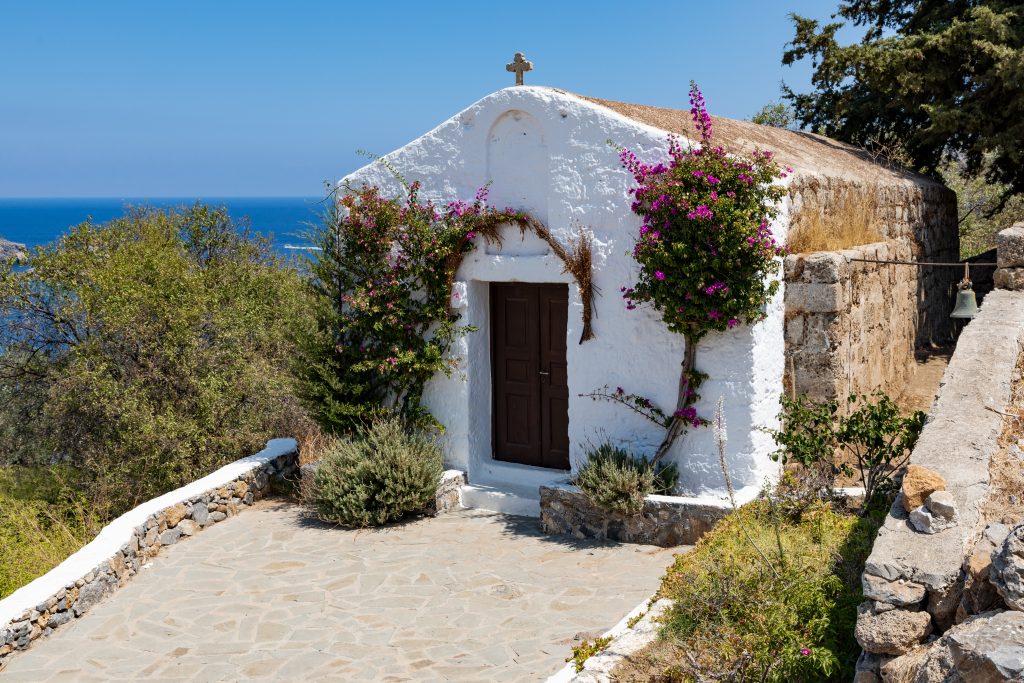
The villages of Embonas, Kritinia, Profillia, Monolithos, Agios Isidoros, Laerma, Mesanagros, Siana, Psinthos, Arnitha, Salako, and Agia Eleousa retain the original vibe of the Rhodian countryside. With the old castles, churches and beautiful buildings. In small tavernas, you will find traditional island dishes. In the ancient cellars of the mountain villages, you can taste the same Rhodian wine that used to be transported to all the coasts of the southeastern Mediterranean.
Afandou (Afantou)
The village of Afandou on Rhodes was founded at a time when pirates invaded the islands of the Mediterranean. To hide from these pirates, they sought shelter inland. The village of Afandou takes its name from the word “áfandos”. This means “invisible” in Greek because it could not be seen from the sea.
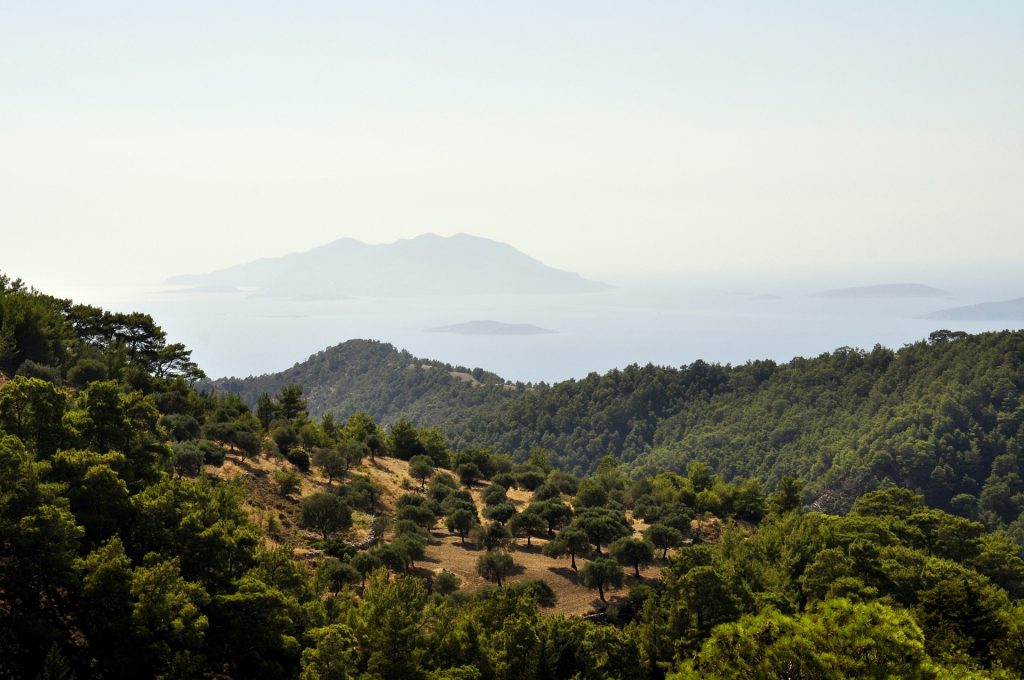
Fanes
Along the west coast road of Rhodes is the village of Fanes. Located just after Soroni, it has a picturesque harbor and a flat, isolated beach. The many tamarisk trees provide some natural shade. Fanes is also known as the village of colors. Here the local artist Lukas has created his artwork which can be found everywhere. It is a real inspiration to walk through.
Apollona
The village of Apollona takes its name from the Temple of God Apollo. this God was at that time the protector of the island of Rhodes and the fine arts. The village of Apollona has only about 1000 inhabitants and has rich vegetation with more than 70,000 hectares of land. The majority of the people in the community are mainly engaged in the cultivation of olive trees.
Archangelos (Archangelos)
The village of Archangelos (Archangelos) and its inhabitants are highly valued and faithful to traditions. The center of the village is dominated by the Church of the Archangel Michael, with its beautiful bell tower from 1845.
Kritinia
In this village, you will immediately notice the medieval castle that overlooks the sea towards Chalki. It stands on a pine-clad hillside on the northwest coast of Rhodes. It is called the forgotten border region by the inhabitants of the village. What really makes it worth a visit is the wild beauty of the landscape.
Gennadi (Gennadi)
The village resort of Gennadi is a peaceful and quiet place. With pink villas with towers and futuristic structures, virgin sand, hotels, and beach bars.
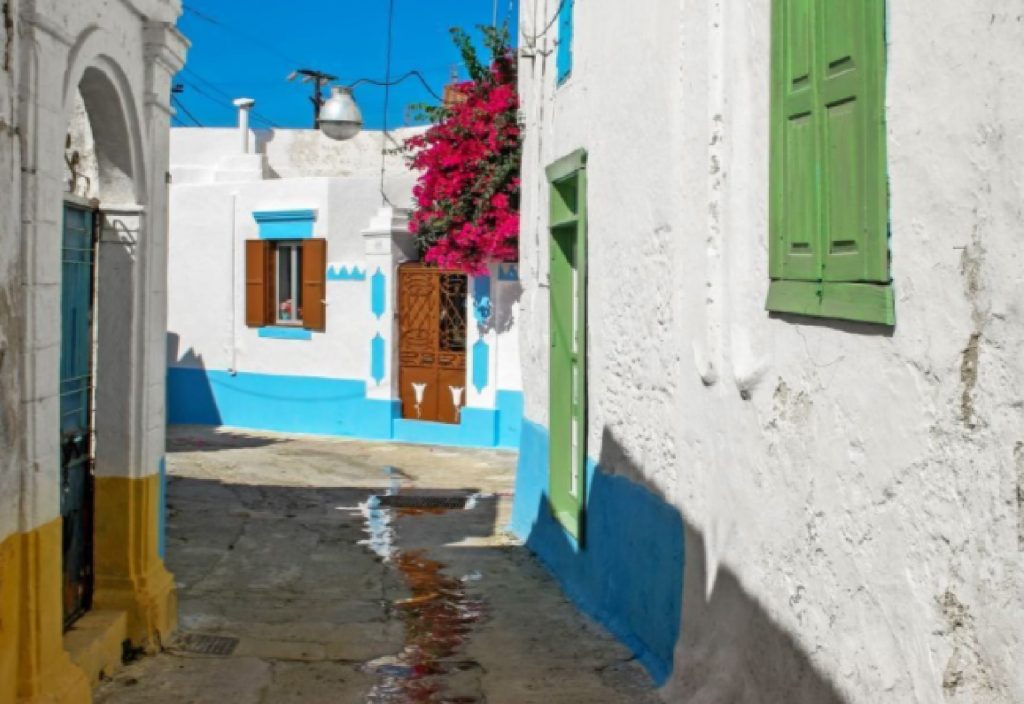
Koskinou
A village with front doors painted in vibrant colors. Made of wood or iron, with carved or etched designs. Small gardens with their cobbled floors hidden behind the interior doors. Koskinou in Rhodes is known for its unique mosaic of colors.
11- Kameiros (Kamiros)
The archaeological site of Kamiros is located on the west coast of the Greek island of Rhodes. About 36 kilometers from Rhodes town. Kamiros was the smallest of the three most important cities of that time.
Kamiros was a kind of agricultural town where wine and olive oil were produced. This was even mentioned by Homer in his books. The remains that can be seen today in Kamiros are those of the city that was rebuilt in 226 BC in the Hellenistic era, after a catastrophic earthquake. Before that, the city had existed since Archaic times. Long before Rhodes Town was founded, Kameiros was one of the largest urban centers on the island, occupied from prehistoric times by the Mycenaeans.
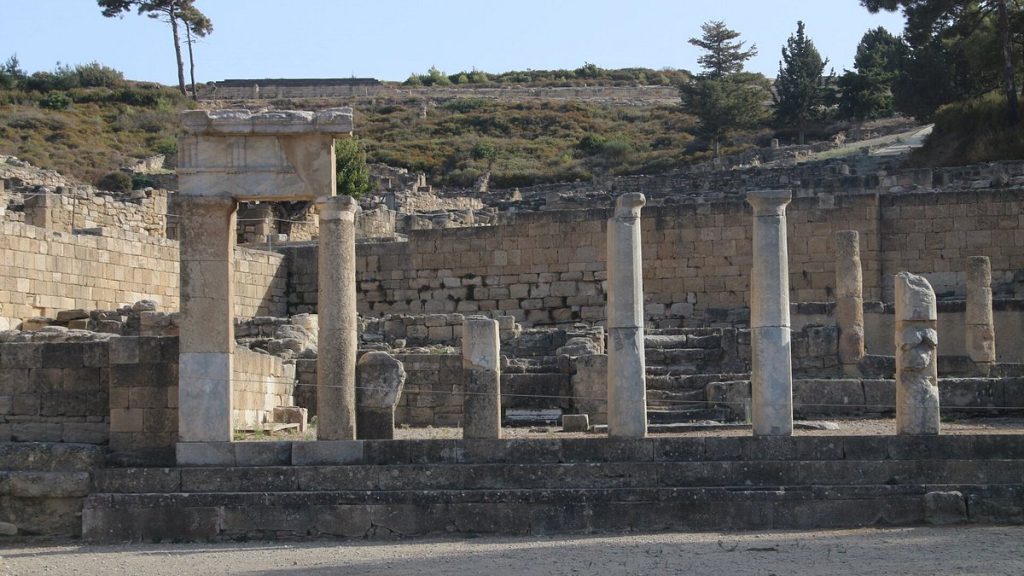
On a terrace at the top is the Acropolis, with the remains of a temple to Athena Kameiras. And a stoa with two rows of Doric columns and a reservoir that can hold 600 cubic liters of water, with terracotta pipes leading it to the living quarters below.
On the middle terrace was the main settlement with residential blocks on a grid pattern.
And finally, below is the later Hellenistic temple, a fountain house, agora, and a wall inscribed with dedications to gods like Zeus, Poseidon, and Artemis.
12- Monolithos Castle
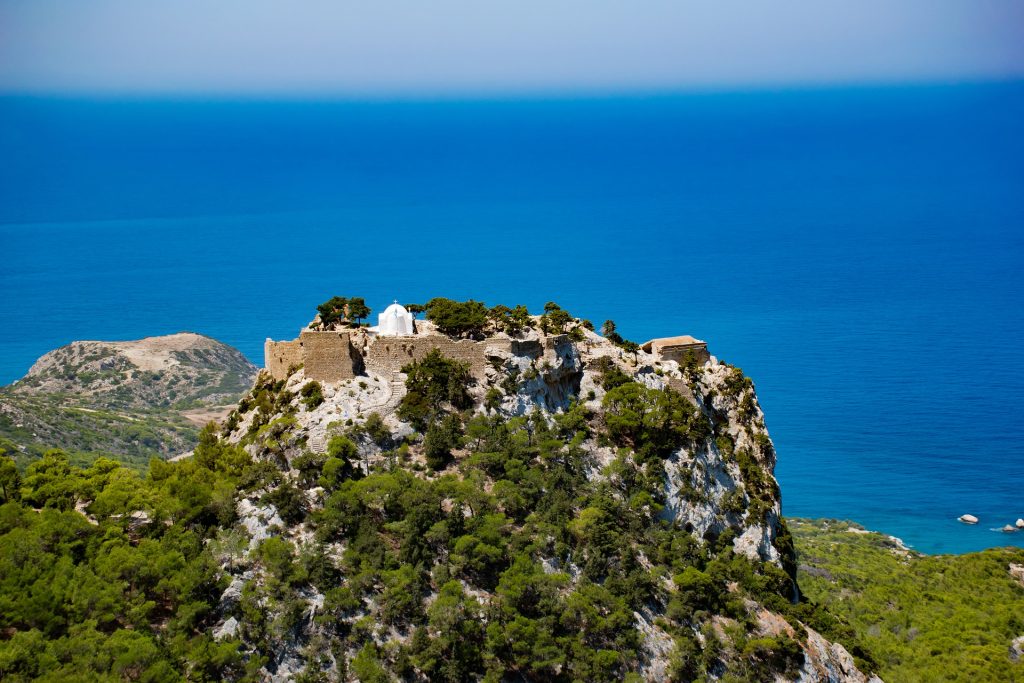
This monument is located high on a rock 100 meters above the west coast. It is a bit away from the tourist centers of Rhodes. Monolithos Castle is a 3 km drive from Monolithos village. Once you reach the rock, you must continue your adventure on foot, via the steep footpath that leads to the castle. But once you’ve conquered the stairs that wind up the cliff, you’ll find that you won’t regret the trip there.
The castle of Monolithos was built on the foundations of another, older castle. It sits about 236 meters high on an astonishingly difficult natural terrain. This made construction even more challenging.
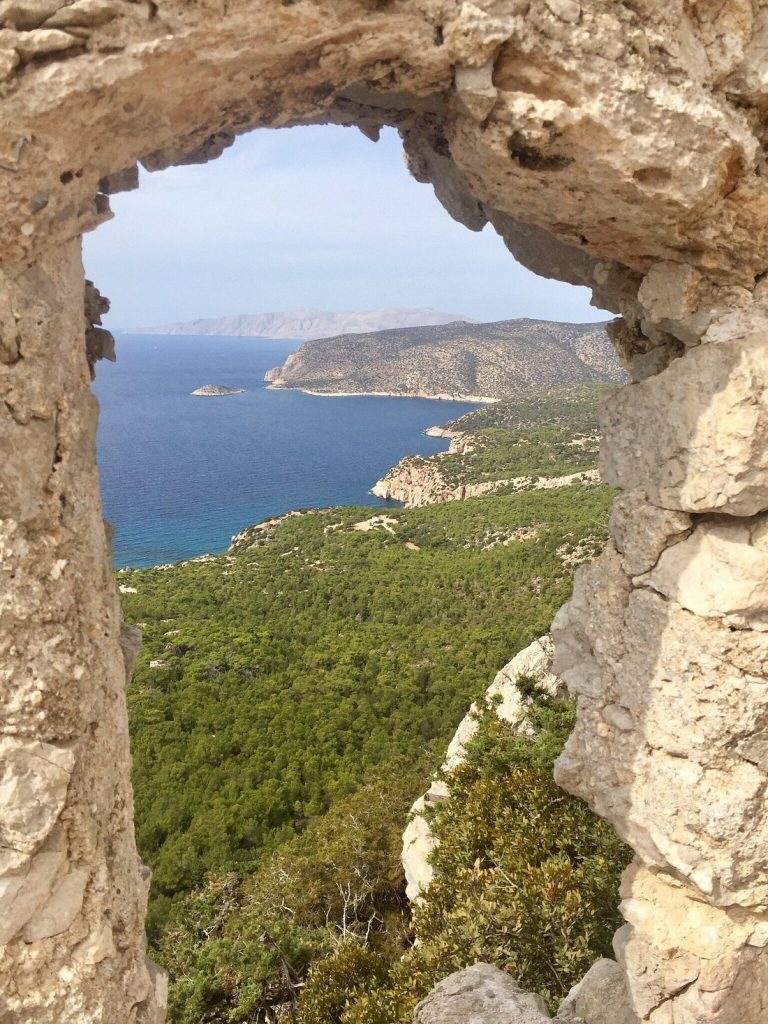
The monument was erected by the Knights of St. John Monolithios Castle and was once one of the four most powerful strongholds on the island. It was never conquered. Within the walls are two 15th century chapels, to St George and St Panteleimon.
Best of all, though, you can scramble up the rocky trails lined with pine trees to overlook the rocky cliffs atop Mount Akramytis beyond. The view of the sea and the small Dodecanese islands is amazing.
From the city of Rhodes, the distance is 69.5 km.
13- Butterfly Valley
On the western side of the island of Rhodes, about three miles southeast of the village of Theologos (or Tholos), is the Valley of the Butterflies. Also known as Butterfly Valley (Petaloudes in Greek). This is one of the most attractive destinations on the island.
The Valley of the Butterflies (Petaloudes) shows another of the island’s landmarks: the “Zitia” tree. It is only found in a few parts of the Mediterranean. It is home to millions of butterflies that hang peacefully in the shady wet trails. Created with the stream, which occasionally turns into lakes and small waterfalls.
In August, thousands of butterflies of the genus Panaxia (species Quadripunctaria Poda) swarm into the butterfly valley to reproduce. The pleasure of watching the butterflies at rest should not be denied to visitors, but it is forbidden to disturb them in any way (clapping hands, whistling, etc.).
14- Day Cruise with Snorkeling and Lunch
Board Romantika, a classic 22-meter yacht, for a sail along the beautiful coast of Rhodes. Enjoy a buffet lunch and drinks and time for snorkeling. Departing from Rhodes City.
- Swim and snorkel in the most picturesque bays of Rhodes
- Sunbathe on the comfortable deck of the boat
- Enjoy Greek wine and a buffet of local delicacies
Romantica sails daily at 10:00 AM on a cruise to the 3 most beautiful bays on Rhodes. Sunbathe, swim, and snorkel with your friends and family! The first stop is Kallithea Springs, an ancient therapy spa. Next is the Caves of Traganou at Afandou Beach, where you can snorkel inside the rock formations. The third stop is Anthony Quinn Bay, a picturesque pirate shelter with abundant underwater life. Enjoy a lunch buffet of Mediterranean, seafood, and vegetarian dishes, prepared and served on board. The crew will keep your glass filled with chilled wine, cold beer, or juice throughout the cruise.
To skip the lines you can book online here: Day Cruise with Snorkeling and Lunch
15- Visit Symi Island
Symi Island Greece is one of the most beautiful gems of the Dodecanese island chain! It stands out from the other Greek islands with its beautiful architecture, colorful houses, and relaxed atmosphere. Symi harbor looks like it popped out of a painting! The first thing you notice when approaching Symi by boat are the colorful mansions around the harbor. Everything about this island exudes charm! Symi harbor is without a doubt the ultimate place for romantic walks and sunsets! That is….if you have time for that….
The harbor is actually also the center of the island. Within walking distance, there are many small villages and beaches to find and discover. If you can manage to get away from the extremely romantic harbor, Symi’s beautiful beaches are well worth the effort. They may be small, but they are clean and have enchanting crystal clear waters. Some are organized but the rest are secluded so ideal for those wanting to relax away from the crowds!
You can take a ferry from Rhodes to Symi or book a wonderful high-speed boat cruise to Symi Island. Click here for tickets and more information. Take a speedboat cruise to the scenic island of Symi. Enjoy free time to explore the fishing village and swim at one of the most beautiful beaches in St. George Bay. For approx. €40 pp.
Conclusion
What an incredibly beautiful island Rhodes is! And you do the island so much short by only having a limited number of hours to spend there. Of all antiquities, history, the beautiful nature, the fantastic beaches with the clearest water, but also all the picturesque authentic villages …. you really run out of time. I hope these 15 BEST THINGS TO DO IN RHODES give you an easier choice on how to spend your day here. Enjoy this beautiful island and decide to come back here for a longer period of time to better absorb all the beauty.

